#you wielded it superbly
Text
Mad respect for the player named “DJ Octussy”
#props#even though you wielded the trash can#you wielded it superbly#splatoon#splatoon 3#<3#dj octavio
59 notes
·
View notes
Text
Power and Desire
I've often felt that people that thirst for power seldom know how to wield it which is why it is extremely satisfying when power and authority rests in the hands of ones that actively shun it, knowing that it corrupts from within . Kalki Krishnamurthy must have felt the same way.
Why else would he write that splendid ending for Ponniyin Selvan if he felt otherwise?
Ponniyin Selvan has so many painstakingly etched narrative arcs but the penultimate story arc where the cards are revealed and the lots are drawn is a masterpiece in story telling . For the most part of the novel Senthan Amuthan comes across as a naive , innocent and plain odhuvar whose single goal in life is to love his cousin with no hopes of winning her hand.
The readers don't realize until much later that this man has lived most of his life as a penance for a single lapse in judgment made by his mother. He knows he has a right to rule and claiming that right would give him love, power and a mother, but he just doesn't act. He is staid and calm, undisturbed and uncaring about the war of succession that's happening . He has no personal ambitions except for winning Kuzhali's hand and helping her where he can , even if it means losing her affections
Even when Kuzhali reveals her ambitions to be queen , he stays firm in his resolve and doesn't reveal the secret of his birth . Therefore , it's extremely satisfying when Kuzhali accepts his suit and it's revealed after that he's the original Madurantaka . This emotional heft carries well into the coronation ceremony where Vandiyathevan has to physically restrain Amudhan in order to crown him King.
The emotional center of Ponniyin Selvan is centered around Amudhan post Adithan's death and in discarding this story arc in favor of a war with the Rashtrakoota King Amoghavarsha and the subsequent crowning of Madurantaka (not Amudhan) , Mani Ratnam loses most of the emotional heft he's constructed for the movie. The fact that he teases the book loyalists with a lot of cues peppered through the narrative and then discards the same cues for that damp squib of a coronation ceremony doesn't help matters.
A stunning piece of story writing from the novel is reduced to a perfunctory under-thought ending accompanied by hastily undercooked music . Amudhan and Kuzhali are bidden hasty goodbyes and seeing the undeserving Madurantaka win the crown makes me wonder if MR wasn't invested enough in characters other than Aditya to think things through.
Like the much maligned Amudhan , I too bid a hasty good bye to this ending that reduces a stunning movie to a mere good one.
I will rewatch and revisit this movie multiple times . It is superbly written for the most part and carries its emotional weight in gold until the last narrative arc. But every time I rewatch this , I will always go back to the book and imagine an alternate reality where the movie was thirty minutes longer and delivered power to the one that actively shunned it .
Fare thee well Amudha - at least the book did you good,
47 notes
·
View notes
Text
15. Enemy
The conclusion of the Azata Fleshmarket Massacre for @starlightcleric's Owlcatober 2022 challenge. The rest on AO3.
***
No one had died—at least not permanently. Woljif had never seen the Count this disheveled, even after an all-nighter. Seelah was ashen but couldn’t stop grinning. Aivu was ecstatic, running circles around them all despite a limp in her back leg. The Merry Band, exhausted and soaked in gore, made their way through the meadow that was once the Fleshmarket, now a riot of flowers and demon corpses.
Before the portal, Siavash stopped and turned to Early Sunset. The Azata had shed his demon disguise, once again in his graceful corporeal form, but his slight smile looked a trifle tense at the edges.
“Early Sunset, I have a few questions for you.”
Don’t pick a fight now, chief, Woljif thought, hands moving nonetheless to his daggers. At least he hadn’t been the only one to notice something was amiss. Arueshalae unshouldered her bow.
The Azata affected surprise. “What is it, my friend?”
“Lots of small things, I guess. Ramisa knew you on sight. There’s no way she would have trusted you so easily. And you were ready to trade a slave back to her for Aivu. What kind of an Azata would do that?”
“Yeah, and warning the slavers to tighten security?” Woljif piped up.
“You didn’t even react to the Song of Elysium,” Arueshalae added, watching him intently.
Early Sunset took a breath as if to begin a litany of excuses, then apparently changed his mind. His face seemed to relax, but instead of calm beauty, it betrayed venomous contempt. “Fine. Acting never was my calling.”
Suddenly the Azata’s form warped and burst. A sulfurous wind blasted their faces. The light of flames sprang up, and before them rose a giant, superbly handsome, terribly symmetrical devil, three sets of wings, elegant horns, eyes of infinite cunning, radiating crushing power.
“Please allow me to introduce myself,” he said, the honeyed voice of Early Sunset stripped of its feigned warmth. “Mephistopheles, Archdevil of Hell.”
Arueshalae went deadly pale. “This… is so much worse than I even imagined.”
“By the Light of Heaven!” cried the Hand, reaching out to shield them.
“Spare me. I have no interest in attacking you and attracting the attention of the backstabbing mistress of this city, who I understand has a pathological obsession with killing people like me.”
“Why the charade, all this time? You could have killed me in my sleep!” Siavash was livid. He looked drained, but his hand was on his sword hilt and the unpredictable light of Elysium in his eyes.
“You see, this only demonstrates how tediously limited mortal minds are,” said the Archdevil with an annoyed sigh. “I will explain, but only because you clearly have no notion whatsoever, and your ignorance infuriates me.”
“I’ll tell you who’s tedious,” Aivu yawned.
“I have been keeping an eye on you—personally—because you are a problem. A fly in the universe’s ointment. A weapon out of control. As long as you were aimed at Hell’s enemies, that insulting conniver Baphomet for one, there was no call to interfere. However, the threat you represent is rapidly growing more urgent.
“Your slow, limited little mortal brain cannot even come close to grasping just how dangerous you are. Even the most chaotic of creatures, gods and demons alike, are bound by universal laws. Contracts. Tell them that—it makes them slobber with irritation. Yet it is true. In exchange for the power we wield we are all ensnared by the machinery of the millennia.
“You, however, are not. A mortal imbued apparently randomly with godlike power, you are subject to none of the constraints this universe’s balance depends upon. You wander across planes, wield your ever-growing power, lay to waste the established order of existence, and Hell has no lawful means of stopping you.”
Aivu shifted from claw to claw, rolling her eyes. “Ugh, do we have to listen? Lectures put me to sleep.”
Mephistopheles leaned down and peered at him as if Siavash were a tiny, stinging bug. “You are the fragile, insignificant butterfly whose wings set in motion violent storms across every plane of existence. You’re much worse than Baphomet, Deskari, and all the demon lords combined. And that’s saying something.”
“What do you plan to do about it?”
Woljif cringed. He didn’t have a single spell. Every bone in his body hurt. His stomach sloshed with potions. They couldn’t possibly fight an Archdevil right now.
“Did you forget already? Nothing. Here in the Abyss, anyway. You and the demons go right ahead and have at each other to your hearts’ content.
“Be assured that if you survive this—which I really didn’t think you would today, despite my careful planning, congratulations—we will meet again.”
“Whatever. I don’t have time for you. Get in line.”
With a contemptuous snort, Mephistopheles flicked open a portal and vanished.
The Merry Band all exchanged a look.
“That’s gonna come back and bite us,” said Lann.
“Ha. Let him try,” said Seelah.
Siavash started for the portal but stopped on its threshold and turned around. “Uh, Merry Band, a quick diplomatic request? When we inform Regill about what’s happened, can we not mention too much about that conversation? Don’t lie to him, of course. Just… curate the details.”
Once they were back in the Nexus and the freed slaves were settled, and everyone washed up and bandaged, Woljif found Siavash sitting by the fire wearing a very pained expression.
“What’s the matter? You look like you bit into a pasty and found half a worm.” With a little grunt of pain, he lowered himself carefully to sit down next to him.
“I was just realizing I confided quite a bit in Early Sunset.”
“About what, exactly?”
Siavash looked at him, cringing.
“Ah no, not about me.”
“It was before. You know. About my dilemma. About falling in love with you.”
Now Woljif was cringing too.
“He never said much. He seemed like such a good listener. I told him all about my previous relationship, my guilt, my feelings for you…”
Suddenly Woljif doubled over in hilarity. “And—all this time it was—ha ha—”
“It must have been torture for him.” Siavash burst into laughter too. “Can’t say I have much sympathy.”
After a few minutes they both wiped the tears from the corners of their eyes and Woljif looked at him and felt that funny, light feeling he got sometimes, and moved a little closer. “Did you really—I mean, you liked me that much? Even back then?”
“I wish you could see yourself through my eyes, Woljif.”
Woljif glanced over his shoulder to see if anybody was looking, and sadly, the whole Nexus camp was swarming with people now. They wouldn’t have one moment alone. And then he decided it didn’t matter. He scooted over and threw his arms around Siavash and kissed him on the lips right in front of everybody, and if they thought that was weak and mushy they didn’t get it, not at all. It took a lot of guts to love somebody like the chief.
For an instant he expected to hear an impatient hiss in his ear telling him how pathetic he was and whispering about power and revenge, but it was gone now. His shadow had finally shut up.
Siavash threw his cloak on the ground and lay back contentedly with his head in Woljif’s lap, an ache of exhaustion in his limbs as they settled on the unyielding stone of the Nexus. It was the good kind of tired.
He wasn’t sure how he’d done it. It was like his heart had been squeezed dry by the Abyss—and especially his terror at Aivu’s kidnapping—and somehow the divine power he had been granted had filled it back up with a flood of Elysian energy so massive it had spilled over and poured into the Abyss like a tidal wave. All he had to do was will the destruction of the Fleshmarket, and like lutestrings his will resonated with the will of Elysium, and its music and power poured out of him. He might not lead the Crusade anymore, but he’d left his mark here for a good while to come.
Mephistopheles hadn’t been wrong. He was learning to flap his wings. To channel the divine power of Elysium.
Or so he believed.
#pathfinder wrath of the righteous#pathfinder wotr#pathfinder#wotr commander#woljif jefto#owlcatober 2022#fanfic
13 notes
·
View notes
Text
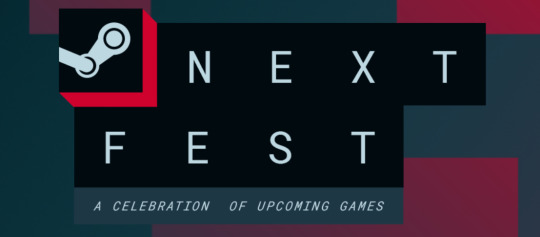
Steam Next Fest, October 2023
Played a score of demos, as I am wont to do, to find new things of interest and confirm if the ones I already knew or not can clear the first hurdles or crash and burn.
I played these 19 demos:
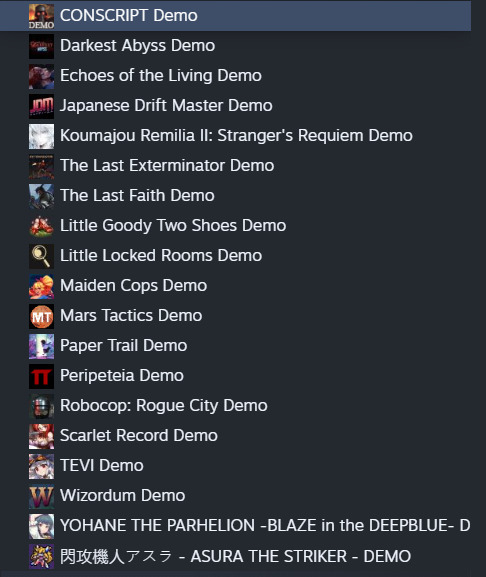
I'll put 9 in this post, and 10 in a second, just so the post editor doesn't shit itself from length issues. Going down the list in the order above - really, Asura the Striker should come first but with the English UI, Steam biases non-Latin characters to the bottom.
I flinched every time the Unity logo came up, those poor bastard devs.
Continued under the read more.

Conscript
Coming from Australian solo developer Jordan Mochi (the studio, Catchweight Studio, is just him at his house), Conscript is a survival horror game set in the middle of the Battle of Verdun in 1916, the longest individual battle in the First World War. While there have been quite a few games, indeed some in recent times, that utilise the horrors of the First World War as their setting and something to reflect on or just as a source of misery or pathos, I actually can't think of any that are just directly a survival horror game.
Conscript acquits itself superbly, using that setting superbly. You are a young French soldier at the frontline trench separating the French and German forces, and the miseries of trench warfare and all that plagued it (enemy artillery shelling, chemical gas weapons, failing roughshod infrastructure and non-existent supply lines) lend to a dirty, grimy brown and grey misery pit that's much more grounded than the usual ones for horror games.
The integration of setting and mechanics, elements and aesthetics come together so well. The chaos of the First World War and its conflicts are used excellently; the opening event of the game, where you are shepherded out to hold the line, has enemies continuously appearing from nowhere. German soldiers, speaking a language your protagonist doesn't understand and can't make out, equally driven to their limits with some appearing haggard and lanky like beasts, wielding only trench shovels or cudgels (as their ammo also runs scarce), they fit their moulds for survival horror enemies very well. The assault ends after a set amount of time, and no clear direction or indication of this is given; you're left to fend against the incoming waves with whatever ammo, guns and tools you can find.
Your primary guns, the rifle and pump shotgun, need you to hit the reload button between shots not to reload but just to chamber a new round/pump a shotgun, which provides that little barrier to seamless combat that a good survival horror needs. Melee combat is awkward and messy. You can stop enemies from respawning by plugging gaps at the trench walls with barbed wire, as if boarding a window from zombies, cigarettes are traded for upgrades/resources, the horrors haunting you are often artillery or creeping gas as they are enemy soldiers. It comes together so naturally.
The graphics are also of particular note; whether they're sprites or models, the character sprites carry the look of 3D models rendered as 2D sprites, a type of style I mostly associate with the Gameboy Advance, where it was regularly used to awful effect. That console's library is plagued with some of the most hideous games you'll ever see, when it was so capable of absolutely gorgeous 2D visuals, a plague spread round the industry by things like Sony America's anti-2D mandate during the PS1 era. Conscript uses a similar style to excellent effect; it looks nice on its own terms and it fits with the moody, atmospheric approach the game takes. It truly is all in how you use it.
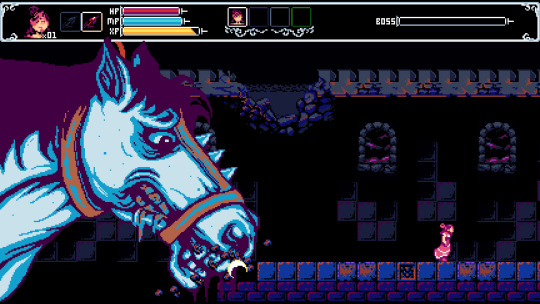
Darkest Abyss
Coming from Brazilian indie studio 2ndBoss, Darkest Abyss trumpets its obvious inspirations and goals from its description; it's a 2D platformer in the vein of the classic NES Castlevanias, a style it apes very well, with the usual sneaky breaking of hardware limitations for grander displays.
Darkest Abyss is a very competent take on the formula, if one that's a little easy. Your subweapons in particular are pretty good and the game is generous with refill items, and indeed a lot of rooms seem explicitly designed around subweapons that they hand to you at the start. The diagonal attack one oneshots even beefy enemies and shreds even the stage boss very quickly, the only tricky part of the demo level is the auto-scroller where a giant horse (above) slowly pursues you due to its use of blocks that break under your feet. Go too fast and you'll run out of blocks before you can see where you can jump to.
I have two issues with Darkest Abyss, one a little fiddly thing and one a flavour thing. For the former, in an attempt to be helpful with mounting and climbing the infamously fiddly Castlevania staircases, Darkest Abyss makes them work such that you can just hold left/right into them and your character will climb them, no need to mess with up/down. Problem is, when ascending, your character passes by the bottom step a little, before turning and going back and then ascending. This makes it super easy to be faced the wrong way from impeding or incoming enemies when you didn't mean to be, and you can't extract yourself from the stairs so easily. It also loses a bit of nuance, where in games like Bloodstained: Curse of the Moon or Grim Guardians, you can walk at a ledge where a staircase is going down and just walk off the ledge for a fast descent, either for speed reasons or to tactically escape enemies and pivot to hit them as they approach. This is ultimately a minor issue, though, once you realise it's how stairs work you can just work around it.
The flavour issue comes from the game's intro cutscene, setting the stage of the world and the tale of King Dracula. During it, after describing Dracula's monstrous reign, it pivots to describe at length a demon who looks like an old man with a massive sword called Furcas, and how he's a wandering badass who kills all he sees, summoned by the Church who lost control etc etc. The problem isn't that per se, it's that it then awkwardly pivots to your actual character Lucy, a half-vampire desperately seeking to kill Dracula who turned her to break the vampire curse before she zombifies (and the flavour of how she stalls the curse's progress is pretty rad, an ornament with a weeping demon singing that somehow slows its progress). Then, at the end of the first level, you find Dracula dead with Furcas' big sword in his neck before fighting the first boss, who is not Furcas but just some demon that a wizard has been sealed inside. The characters are then curious about who could've done this, who is this mysterious Furcas, etc etc.
I'm making a lot of hay by explaining it but basically it would've been cooler to not detail and show and hype up Furcas at the start awkwardly between the two points that matter immediately (your character and her initial goal) and instead have the subversion hit properly and the explanation doled out over the course of the game. Narrative matters even for games with simpler, more limited delivery of it.
Still, Darkest Abyss seems pretty cool and I'm looking forward to seeing if it sticks the landing.
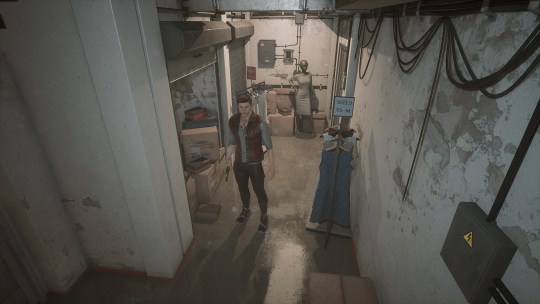
Echoes of the Living
Comparing a game to existing ones, especially big brand or prominent/important ones in a genre, is a good shorthand for explaining and introducing them to people or selling people on them, but some can see it as annoying. In posts like this I often do it because a lot of indie games (at least the ones that I play, which is perhaps telling of me) are clearly and sometimes openly directly trying to capture the specific feeling of a specific IP, or to mimic and/or build upon its gameplay and mechanics because the developers loved it (such as Darkest Abyss just above us). It's reductive in some ways, sure, but it's useful and sometimes it's just the only way to sensibly do it.
All of this is to say that Echoes of the Living, by Spanish developers MoonGlint, is a survival horror clearly in the vein of the classic Resident Evils, with visuals more reminiscent of the Gamecube remake of Resident Evil 1. I think that's pretty explicitly the goal; the game opens with a "This game contains scenes of explicit violence and gore" warning screen of the same exact fashion as those games, which all games referencing or inspired by Resident Evil are fond of doing. And, I think, it mostly gets there!
The movement is perhaps a little twitchier, but its tank controls work, the shooting works the same ways with the same nuances of aiming down to hit downed foes or aiming up to get higher critical chance, you've got your herbs for healing, gunpowder for crafting ammo, and so on. It's got the vibes down, the environments look great, good stuff.
There are a few design issues, though, which dings it a bit. Which is to say, in the 27 odd minutes I played the demo, I couldn't reach the first save room. Not because the game is vicious and finding my way there was too fiendish, no; it's just fucking buried behind a good two dozen or more rooms of zombies and items. This is an issue because the save room is also where the item storage is, and EOTL is actually very generous with items outside of healing ones - you've got more than enough bullets to clean out the initial areas of the pub you reach after the opening streets segment and still have plenty to spare. But your limited inventory also has to hold puzzle items, and if you pick up some keys and can't find the doors they go to they're just going to clog things up and get in the way of more resources or puzzle items. You're dying for that storage crate pretty quick.
Less serious but just kind of odd are melee weapons; EOTL has degrading melee weapons like baseball bats that can be used to kill zombies without spending bullets, but despite being described as being for this use, they are way more scarce than bullets. In fact I only found one, I think, the one it gives you at the start when introducing them, and it's great, it's five or six free oneshots if you aim for heads, but if they're meant to spare your ammo reserves for more important moments their scarcities should probably be flipped.
There is one more issue:

Can you read the text on for that item without pulling the image out and zooming in further? I couldn't on my huge 48-inch TV about a metre and a half from me, and the game was running at maximum resolution and settings and all. It's compacted down to make room because that entire right side of the screen is intended for the storage crate when you get to it. But, well, there's a reason why Resident Evil and others have bespoke separate screens for storage crate item management, it's for ease of use. Compacting the inventory screen like this isn't the best idea, that screen space is wasted any time you're not at a storage crate. It's admirable to want to be efficient, but sometimes you need more menus and screens!
Echoes of the Living is a good effort and I hope to see at least the inventory screen tidied up if not at launch (which is soon) then afterward. The rest would require a bit more shuffling of rooms or item design, but otherwise it holds up well. At some point I may well come back round to it.
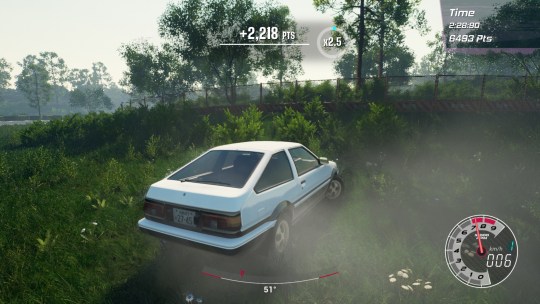
Japanese Drift Master
I usually try a racing game out in Steam Next Fests when I see one, because I've always been fond of different kinds of racing and car games, but only ones about high-speed sci-fi racing like F-Zero or Fast Zero RMX really stick with me. I suck at basically all others, even though I like shit like Crazy Taxi and have liked the idea of ones like the older Need For Speed games and all, and especially old arcade racers. I can never wrap my head around games where they behave more like actual cars and not karts or lightspeed hover cars.
This is one of those; coming from Polish developer-publisher Gaming Factory, JDM is more "realistic simulator" than you first might expect given the subject. It has a bevy of detailed control and handling options and fairly straight-laced but nice realistic visuals once in-game. I'm not qualified to say how good it is at those options, but it seemed to have its shit together even to a layman like me.
Perhaps my idea of drifting has been somewhat warped by Initial D memes and more arcadey racers, but it feels like there isn't quite enough space on its realistic tight-streeted world map or in the event I tried in it, but I am inept at this shit. I passed the event with a bronze medal by managing to drift in a consistent circle in a wide enough spot in one of its turns. At some point I need to sit down and pick a game and commit to it to get a feel for how to handle things, otherwise I'll just never vibe with them.
Still, JDM seems pretty neat if you're looking for a fairly realistic simulator with an emphasis on pulling drift tricks.
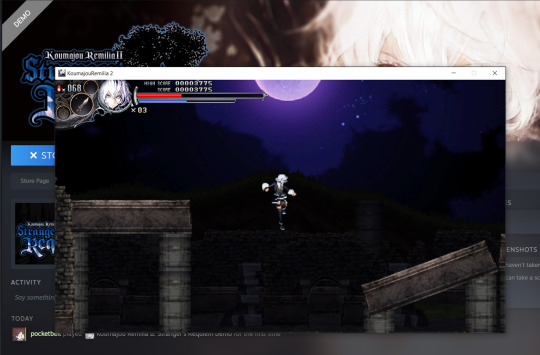
Koumajou Remilia II: Stranger's Requiem
I still haven't played the original non-Steam PC release of this, or gotten around to the Switch version of the first game (which I own), but I did play the original Koumajou Remilia some years ago and was fond of it. Coming from Japanese indie dev Frontier Aja, this a Touhou fangame that apes Castlevania openly, aiming for its aesthetic and musical style as well as the gameplay, but blended with Touhou. Its character illustrations in particular are fucking incredible.
Regrettably, this port or version is something of a fucking mess. The screenshot probably gives you some immediate ideas; this game can't be full-screened, and there are no graphical or performance options of any sort in its menu at all. There's not really an options at all, which is really unfortunate because the game's default controls are fucked up, with multiple actions bound to the same key by some accident or glitch. The game's tutorial will tell you buttons for swapping subweapons/summons or performing certain moves and they'll often do nothing or just stack up, as they either overwrite each other or clash. You can't actually cycle subweapons with LB & RB on the Xbox controller, for instance, neither of them do anything. One of the cycle directions is bound to Y, which is also your backstep button. The flurry attack performed by hitting Up + X is also bound to B, which is your subweapon usage button. And because it's going at the same time as the subweapon, it often overwrites or prevents their usage.
The game defaults to Switch button layouts so this might even be a bad port of that version, in which case hopefully the Switch ports avoid these issues. I'll have to see by busting it out, and if so that's good, and if not that's a horrible, horrible shame. It does remind me that I still need to get around to Touhou: Luna Nights.
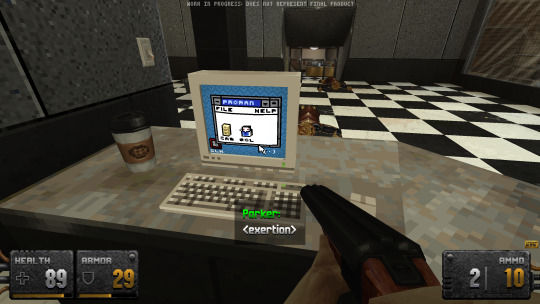
The Last Exterminator
Something that struck me over the last week, amidst news of service games dying away and losing all their money, was how far we've come from the awful bastard days of cover-based shooters. The drift to the current "Boomer Shooter" renaissance was gradual, exploding with Doom 2016 in particular and we're still riding the wave. God, how much better things are now with shooters that actually have to give a shit about enemy design, and level design, and can have challenge that isn't just "you were breathed on, sit behind a wall for seven seconds".
From Australian studio Ironworks Games, The Last Exterminator is a prime example of the new wave of boomer shooters; taking obvious overt cues from Duke Nukem 3D in particular (but with actual 3D graphics for you and enemies, more akin to stuff like Quake but with Duke's art style), it's a boomer shooter in basically every way: sprawling levels where paths interweave and criss-cross and turn back on each other, health & armour meters, the usual suspects for weapons, no forced cover system and a very fast protagonist, on and on. It's fucking sublime. It's just excellent.
The demo is just one level, but it's a good level, guns feel fucking great, movement feels great and it looks really nice. It's a plain ol' fucking treat. The core part of this renaissance for shooters is that these old shooters were just plain fucking great, a lot of the time, whereas the horrid tunnel the 7th gen of videogames went down struggled to produce much of any worth, never mind reach even vaguely similar heights. I would even go as far as saying that the only truly excellent shooters of that time were Vanquish and Resident Evil 5.
Last Exterminator does basically everything right - it even already has great gamepad controls out of the box, a bit of a rarity for boomer shooter demos in my experience. A highlight of this Next Fest, easily.

The Last Faith
Sadly, I don't think I've ever enjoyed a 2D "Soulslike", if I'm being honest. Maybe there is one out there, but I've wracked my brains and I can't come up with any I'd call good. If you count Blasphemous that'd be it, but the thing is I don't, I think that's just a pure Metroidvania platformer and not an action RPG at all. It's not that I decree that it can never be done, just that I've never enjoyed one. Partially because it feels like so many fall into weird traps that don't make sense if you've played the games that inspire them.
And like, look at that menu and art above and tell me this isn't just wanting to be Bloodborne specifically. And that's good, more of that is always good. Coming from English studio Kumi Souls Games, The Last Faith misses the key ingredient of its inspiration: speed.
The Last Faith's issue for me is that getting around in its world just feels tedious and fighting enemies feels like a slog. In the name of challenge they want your animations to be very specific and require you to parry moves if you can't dodge them, but all of that just made me feel like I couldn't ever quite move around enemies properly or quickly. And you don't have a block to make up for that, as far as I can tell, because these gits never have a fucking working block/guard system ever because why would you? Who would ever want that.
The thing about Bloodborne taking the block system away is that your general movement and attack speed was significantly increased to compensate. Your dodge becomes a lunge that can close distance incredibly as well as having great i-frames, and most weapons are very fast or have fast forms. The Last Faith doesn't really have that, and it hurts it so much. Both demo characters feel too slow to get around at a reasonable pace and regular enemies take too many hits to feel good.
There's a bad habit among indie devs of assuming that "hard" or hell, "balanced" means "takes longer", that in a "balanced game" or a "hard game" you need to do some "middling" amount of hits to beat things. This makes them tiresome fucking slogs because nothing ever just dies and getting anywhere takes forever. Basic enemies die terribly fast from the very start in Souls games, and no-one ever seems to notice.
I can't say I recommend The Last Faith. The thing is, Bloodborne's still great and it's playable on PS5 as well as PS4, if you're hankering that bad. Its other inspiration, Castlevania (you can tell by the styling of the brawler character and his backdash especially), is represented vigorously and better elsewhere.
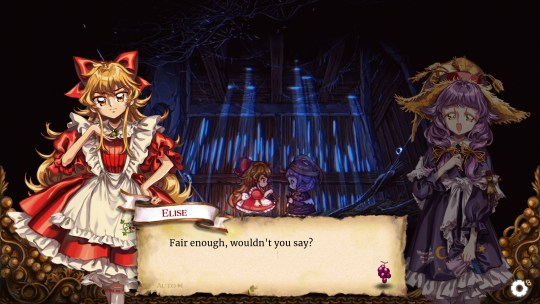
Little Goody Two Shoes
Coming from Portuguese developer AstralShift, Little Good Two Shoes is an astounding visual treat. Its art style, its sprite and animation work and the very tasteful VHS filter are the stuff of dreams. All of the little animation touches, from Elise's portrait in the top left reacting to things to just how she runs or hops across stones to go across a river, all of it is perfect and adorable. It has that 90s anime/PC-98 visual novel art style to it, and its title animation captures the same style immaculately. This is, truly, one of the ideal ways a game can look, frankly.
The demo is remarkably large as this is a slow-burner; a mix of traditional dating sim and a horror adventure game, where you weave your way to one of 10 endings by romancing one of three girls and investigating talk of a witch and demons in the woods around your medieval/early modern German countryside town. It balances these pretty well - there's a hunger meter as well as a health one, giving you a reason to do minigames for money so you can't just devour the dating/horror story immediately, and the minigames are fun besides. It gives the whole thing a good pacing.
It does lay it on thick, too, you get jumped by thorned demon vines minutes into things and get chucked into the thick of time management and arranging dates with your potential girlfriends relatively quick. It's all slickly done, the characters are delightful and mystery abounds pretty quick.
The horror aspects I saw, from the trailer and the demo, aren't my taste for horror exactly but they give the story good intrigue all the same, and Elise is a fun character so seeing her bounce off her love interests and others is a laugh anyway. For its asking price it seems like a fucking steal, and as it's out soon I may well pounce on it quick.
Even if it somehow doesn't stick its landing, I want to see these devs keep at their craft because holy god, it's so fucking pretty.

Little Locked Rooms
From solo developer riolucci, Little Locked Rooms has an adorable premise: a detective making dioramas of locked-room mysteries for his kids to solve. It's a good set-up, and I'm very fond of these kinds of puzzle game, but the demo's single level leaves it wanting.
The demo level involves a thief entering a cabin and then fleeing from it without leaving a trace when the police arrive 30 minutes later, and from the supplied screenshot above you can likely figure it out quick. But the way you have to convey the answer is to pick through a series of questions that aren't always clear in what they want: they want you to pick through the scenario and solve it through the questions, answering each step as if you don't or can't immediately tell waht happened.
So here, you have to answer that the thief exited the house by walking, then specify that he walked backwards through his own footsteps, then specify that he grabbed a tire and then walked back through the tire tracks, using a tire to cover his footprints in the tracks. It makes delivering the answer a little fiddly, but at least with the answers and scoring system, there is some pleasantly surprising nuance: you can pick the tire tracks first when identifying how the thief left, and get explicitly told "not yet" and to find the interim step, and not have your score penalised. It's a flow thing, I suppose; I would prefer giving the answer and then "defending" or "proving it" to make things feel more natural, but maybe that's just me. Maybe the point is figuring out how to work your way there rather than answering.
Either way, the demo level is short and simple. There's promise in this, but I'd like to have seen a more complex diorama and thus what the "average" level of the game looks like, to see what it aspires to. Perhaps at a future Next Fest.
====
Part 2 is here!
0 notes
Text
“…War often necessitated the absence of men from their families and their homes. While we have already touched on the fact that women could exercise military leadership during such an absence, the importance of their domestic role in the context of the husbands’ or sons’ military activities is worth considering, even if the women themselves were not all directly involved in military activity. For, in their men-folk’s absence, women sometimes assumed full control over the governance of the household or estate, along with all the lands which came with it – a role which took on an added significance amongst marriages of the more powerful nobles of Western Europe whose landholdings often entailed extensive seigniorial rights.
Stephen of Blois, for instance, alluded to the power that his wife Adela had whilst he was absent on the First Crusade when he wrote that ‘I send [the wish] that you do well and dispose of your things superbly, and treat your sons and your men honorably, as befits you’. This statement reveals the lordly authority which Adela maintained as regent while Stephen was absent and which she was to retain after his early death in May 1102 – right up until she took the veil as a nun in 1120. The military authority she wielded as lord is demonstrated by the fact that she once sent a large number of knights to support her lord Louis VI (c.1081-1137) while he was fighting rebellious castellans north of Paris in 1101.
But Adela was not the only women whose regency resulted from the call to crusade: when Louis IX went on crusade he entrusted the governance of the French kingdom to his mother, Blanche of Castile, who had proven herself a reliable and effective ruler during his minority. Eleanor of Aquitaine (1122-1204), queen of France and later England, similarly acted as regent in England for her son Richard I while he went on crusade, and was involved in mediating ecclesiastical disputes in his absence as well as in matters of governance. Likewise, Clementia of Burgundy, wife of Robert II of Flanders, held his county while he was left on the First Crusade, much like Eremburge of Maine governed the county of Anjou during her husband’s absence on crusade in 1120.
In the Holy Land the wife of Joscelin the Younger, count of Edessa (d. 1159), governed the county ably after he had been taken prisoner in 1150 – ‘far beyond the strength of a woman’, according to William of Tyre. His remark hints at the way in which medieval women who did govern well were thought by their male contemporaries to have transcended the ‘weakness’ of their sex, much like other comments regarding militant women referred to their masculine qualities in order to explain their involvement. Regardless of how well they governed, though, the key point is that it was war that forced these women to assume governing roles at home in support of their husbands or sons.
Women were also sometimes entrusted with the administration and coordination of affairs in preparation for war. Thus in 1267 the earl of Pembroke wrote to his wife, who had command over the castle of Winchester, informing her that he had sent men to help her defend the castle from attack and instructing her that she had ‘power over them all...to ordain and arrange in all things according to that which you shall see to be best to do’. More striking is a letter sent by Edward III in 1335 to three women: Margaret, widow of Edmund, earl of Kent; Marie, wife of Aymer de Valence, earl of Pembroke; and Joan, wife of one Thomas Botetourt.
In this letter Edward, who was absent fighting in Scotland, commanded these women to gather trusted advisors together in London to ‘treat and ordain on the safe custody and secure defence of our realm and people, and on resisting and driving out the foreigners’ who Edward had heard were massing warships and men at sea. The women were then ordered to ‘arm and array your people...to repel powerfully and courageously the presumptuous boldness and malice of our same enemies...if those enemies invade’. Although we do not know the extent to which these women were successful in carrying out the king’s orders, Edward nevertheless showed remarkable faith in the capacity of these women to prepare for the defence of the realm in his absence – certainly no small task.
Another particularly important arena in which women could directly aid the military effort was through their efforts to help finance and raise money for wars within Western Europe and the Holy Land. Funding for military campaigns was raised in many different ways – taxation, general donations, mortgaging or selling property – and women formed an important part of this process, especially when it came to paying for costly crusades to the East. We have already seen how Pope Innocent III, at the turn of the thirteenth century, began to make greater allowances for women to accompany their husbands on crusade or take a crusade vow if they were able to take armed followers with them to the Holy Land, but what really freed up this process was the promulgation of Innocent III’s decretal Quia maior in April 1213 (which pronounced the Fifth Crusade).
Quia maior stipulated regular liturgical processions of men and women, during which the participants would hear sermons, receive some degree of remission of sins just for listening (according to an earlier letter of Innocent), and pray for God to deliver the Holy Land. Furthermore, it promoted greater financial participation by making it possible for women to finance male warriors to go in their place and also specified monthly Church collections to which men and women could contribute. Perhaps most importantly, Quia maior decreed that anyone of either sex who so chose could take a crusade vow and might redeem or commute it if necessary (in return for a monetary payment), thus widening the number of people who might contribute financially to the crusade movement.
Later papal policy expanded this practise by enforcing the payment of vow redemptions if crucesignati (the legal term used to signify someone who had taken a vow) did not leave on crusade. As far as women are concerned there seems to be not enough evidence to gauge how much they actually contributed to the overall amount of money collected from redemptions, or even how much was collected in the first place. Nevertheless, Innocent’s reforms certainly allowed women to take on a greater financial and spiritual role in supporting the crusades, even if their circumstances prevented them from going on crusade in person.
Vow redemptions were, however, only one means by which women could provide monetary assistance. Often more financially taxing were instances in which women were forced to sell their husbands’ property or mortgage dower lands, which left some destitute and others fighting in the courts for their property rights, as Christopher Tyerman has explored in the case of English women. At other times, women helped contribute funds collectively, especially in the case of poorer crusaders who had to rely more on donations from the whole family, in which case the selling and mortgaging of property was again the most common way of financing a family member for war.
Similarly, women who had control over a significant source of income could play a key role in helping finance men on crusade: Hodgson, for instance, cites the examples of Marie of Champagne and Blanche of Castile, both of whom acted as regents and sent money to their sons while they were crusading in the Holy Land, but has also noted other women whose large dower was a key financial source for crusade expeditions. Another more indirect means by which women could assist the continuing military struggle in the Holy Land came from the revenues of female convents associated with the recently founded military orders, of which part went towards financing the latter’s activities in the East (although these payments were not large and varied from one house to another depending on each convent’s financial means).
Finally, we cannot discount the role female taxpayers may have had in helping pay for war, although again it is very difficult to discern how much women contributed in this regard, since the head of the household (the eldest male) was the one who paid taxes and who thus appeared in tax records. The only women to appear were those active in an independent trade of their own or who were widowed and lived in a house in which no male heirs were also residing, though such women only seem to have made up a small proportion of taxpayers.
Thus, even if most or all tax revenue before the sixteenth century went towards financing war, as has been argued in the case of England, the percentage of the revenue that came directly from female taxpayers would have been much less than that of male taxpayers (though both sexes were adversely affected by the effects of high taxation in times of war). Considering all of the means by which women could contribute financially, therefore, it is reasonable to assume that Western European women were a substantial source of finances for military campaigns, especially for the crusades, although the precise extent to which this assistance actually contributed towards the success of these campaigns is hard to quantify.
Women’s enthusiasm for war and their recruitment efforts formed another facet of their home front involvement. This is one area where women may not have always acted in support of their men, and instead actively tried to discourage their men from leaving, hence the actions of such women are worth exploring as they could have influenced the number of men who went to war. The chances of women successfully preventing men’s involvement in warfare appear highest in the case of the crusades because, although wives’ emotional responses to their husbands’ departure could not prevent the latter from leaving, canon law stipulated both husband and wife required each other’s consent before leaving to go on crusade.
Thus women were, for a period, legally able to veto their husbands’ decision to participate. To what extent women were successful at doing so is not entirely clear – some of those who preached the crusade appear to have felt women were among the ones preventing the crusades from being successful, although after Pope Innocent III issued his decretal Ex multa in 1201, which removed the requirement for men to obtain their wives consent before leaving, they would have had little cause for further concern. These developments suggest that some women, at least up until 1201, were successful in stopping men from leaving, but it is hard to say for certain.
Emotional distress at the departure of loved ones on crusade may have played a role though: Odo of Deuil noted that there were tears on the part of women when the Second Crusade departed, as did Ambroise before the Third Crusade. Some years earlier Fulcher of Chartres elaborated at greater length on the sorrow before the First Crusade: ‘Oh what grief there was! What sighs, what weeping, what lamentation among friends when husband left his wife so dear to him, his children, his possessions however great...Then husband told wife the time he expected to return...He commended her to the Lord, kissed her lingeringly, and promised her as she wept that he would return.’
Departure scenes such as this one, it has been argued, were deliberately used by chroniclers to portray the crusades as a male affair in which women were not expected to participate. Certainly, such an account does reinforce conventional gender stereotypes: the emotionally controlled, pious husband, and the overwhelmed, irrational wife unable to maintain her composure. Nevertheless, it is not unreasonable to assume that some women would have been reluctant for their men to depart and upset if the latter eventually did, although we cannot know the extent of their influence on limiting the numbers of men on crusade.
At the same time, medieval women also seem to have encouraged and even recruited men for war. Thus the author of the Itinerarium Peregrinorum asserted that ‘Brides urged their husbands and mothers incited their sons to go, their only sorrow being that they were not able to set out with them because of the weakness of their sex’. Although gender stereotyping is again evident in the way women’s ‘weakness of sex’ is said to have prevented them from leaving, there are some actual examples of women who tried to persuade men to fight. Adela of Blois, for instance, is well-known for her efforts to persuade her husband Stephen to return to the Holy Land after he deserted and came home during the difficult siege of Antioch in 1098.
Similarly, Alice de Montfort was active in recruiting men, notably her brother (the Constable of France) during the Albigensian crusade, as was, supposedly, Eleanor of Aquitaine before the Second Crusade. Riley-Smith, too, has also discussed women, notably the Montlhéry sisters in the Île-de-France, whom he feels ‘transmitted an enthusiasm for crusading to the families into which they married’ and which can help ‘account for the concentrations of crusaders in certain kindred’ during the early crusades. Of course, whilst the genealogical preponderance of crusaders in certain families does not prove for certain that women necessarily had anything to do with recruiting or persuading men to fight, the examples given above do suggest that we should not discount their possible influence.
Lastly, it is also worth considering the role which urban women active in certain trades had in supplying various resources used in military affairs. For although most women were active in the textile and cloth-making industries during the Middle Ages, there were apparently some who worked sharpening tools and making scabbards for swords and knives, and others who even trained in arms manufacture (making chain mail and fletching strings to bows) – definitely a trade that would have thrived on war. Admittedly, the numbers of women engaged in such crafts were very few and their likely effect on military affairs slight. Accordingly, we should not make too much of their employment or we risk over-emphasising their contribution. All the same, they do at least serve to draw attention to other more indirect means by which women on the ‘home front’ may have supported the whole industry of war by supplying military goods and services.
- James Michael Illston, ‘An Entirely Masculine Activity’? Women and War in the High and Late Middle Ages Reconsidered
#james michael illston#military#crusades#history#high middle ages#late middle ages#noblewomen#medieval
52 notes
·
View notes
Note
what are top three sageuk you would recommend?
This is a tough question! But here I go:
1. First up is a three-in-one! If I'm talking about best/favorite sageuks, then the first thing that comes to my mind is the trilogy from writers Kim Young Hyun and Park Sang Yeon: Queen Seondeok, Tree With Deep Roots, and Six Flying Dragons. They're so good! Each one has a superbly written and portrayed protagonist who has to figure out who they are both as a person and as a ruler, and what they're willing to sacrifice to feed their ambition. These dramas all have everything I need from TV: epic scope, interesting characters, complicated relationships, and a real willingness to interrogate what power is, how it operates, and how people wield it. They all stand on their own, but I recommend watching them in the order in which they were made.
2. I think this has to be Painter of the Wind. I love the way this show really explores the nature of art and the power it has over those who create it as well as those who behold it. Fittingly for the subject matter, this show is gorgeously filmed, and Moon Geun Young is a knockout in the title role (and one of the few cross-dressing drama heroines who is even remotely convincing). Plus, it has a sweet, sexy, heart-wrenching sapphic love story running through its core.
3. Dae Jang Geum. I love a good eat-your-vegetables sageuk, and this is the gold standard. It's slow-moving, but in a way that feels deliberate and never boring. It really makes its palace setting come to life--as you watch, you fall into the rhythms of kitchen life (and doctor life after that), and learn to meet this wonderful cast of court ladies, heroines and villains alike, on their own terms. It also has a hall-of-fame soundtrack (as does Painter, actually), and one of the most low-key perfect romances in drama history.
I could go on! But these are all great and, imho, must-watches for all sageuk fans.
16 notes
·
View notes
Text
A Hero Lies in You
On April Fool’s Day 2019, a video was released showing the latest game in the Yakuza franchise. Many thought it was a prank. The reason why? The sudden change in combat. Gone was the brawler beat-em-up that was associated with the series. In its stead was a turn-based system reminiscent of role-playing games. Characters waiting for their turns before utilising special skills? In a franchise known for its hard gritty storylines about gangs duking it out in the streets of Japan? ‘Haha Ryu Ga Gotoku. You thought you could fool us, but we see right through you. This isn’t our first rodeo and you’re not Square Enix,’ was many a thought when the footage had been viewed by thousands online.
What gamers did not know was that this was no gag. Fast forward several months to August 2019 and it was confirmed that Yakuza 7: Like a Dragon, starring new protagonist Kasuga Ichiban, would actually incorporate turn-based battles. There would even be JOBS!
As I had just finished playing through Kiryu’s story, as well as Judgment, in 2020 I was eager to see what new protagonist Kasuga Ichiban would bring to the table. From trailers, I could already see how much livelier Ichiban would be in comparison to the more stoic Kiryu. And, in contrast to Yagami, he was definitely more of an idiot. A lovable idiot, to be sure, but an idiot nonetheless.
Yakuza 7: Like a Dragon released in a huge week for video games. While I would have preferred to play it earlier, I had other huge titans to wrestle into submission first. Once I had managed to satiate my Ubisoft open-world needs with Assassin’s Creed: Valhalla, I dived head first onto the streets of Yokohama, ready to bust some heads.


The game opens on a play. For a moment, I thought I had somehow purchased the wrong game. But as the lengthy prologue progressed, it was very clear that this was most definitely a Yakuza game. It just needed to set up a little bit of the tale, starting with Arakawa Masumi - father figure and role-model for our erstwhile hero. It isn’t long before players are introduced to Kasuga Ichiban with his trademark ‘punch perm.’ Born in a soapland and raised by those that lived on the fringes of society, Ichiban, rather than being hardened by his experience, is empathetic and not afraid to show emotion. Tasked with collection, he interprets his orders in a way to benefit those that are struggling. His goofball attitude immediately makes him a character one can connect to. And it doesn’t hurt that he’s a bit of a nerd, having played Dragon Quest during his childhood and likening many of the people around him to things in the game.
It’s not long before the plot escalates and Ichiban volunteers to give himself up to the police. Sentenced to fifteen years in prison, he inadvertently extends his sentence when his Patriarch is insulted by one of the fellow inmates. After nearly two decades spent in prison for a crime that he did not commit, Ichiban is released with little fanfare and no waiting convoy. Disappointed, he takes it in stride. The first thing on his order of business: to get his signature punch perm and reconnect with his second father-figure and Patriarch of the Arakawa family.
Along the way, he is dogged by a former policeman: Adachi. At first, it isn’t made clear why Adachi seeks Ichiban for help. After all, Ichiban had supposedly killed another yakuza in Kamurocho, Tokyo. Adachi, on the other hand, was a detective in Yokohama. Why would he have any interest in uncovering the truth behind what had put Ichiban behind bars?
After a few shenanigans are had in and around Kamurocho, our protagonist is shot and left for dead - waking up in a homeless shelter in the heart of Isezaki Ijincho. Climbing his way from rock bottom, Ichiban embarks on a journey to uncover the truth, stumbling upon a series of events and unearthing a vast conspiracy in which he was to serve as a pawn.
Many of the earlier chapters felt a little contrived. In particular was the death of Nonomiya. While it served to move the narrative forward, it was most assuredly a means to an end that didn’t highlight any significant character growth. Poor Nonomiya was fridged just to bring Ichiban into conflict with the Liumang branch of the Ijin Three.
It was only in the later chapters that the story picked up steam - with the confrontations with Bleach Japan and the encroachment by the Omi Alliance. Joined by a menagerie of characters like Zhao, Saeko, Han Joon-Gi, Nanba and Eri, there was a lot to keep track on as the plot barrelled forward at a breakneck pace, connecting Ichiban’s past with his current present and all the while setting up a juicy conflict between two men that could have been brothers. And honestly, the ending with Arakawa Masato and Ichiban got to me. I loved how that Ichiban was finally able to reach his old charge by being vulnerable and finally letting out a little of his resentment at the life Masato led, despite the fact that he could not use his legs.
The characters were superbly written and their motivations were a good reflection of the human condition. The themes of family and finding a home were evident, right from the start, even though a lot of it was glossed over by Ichiban’s desire to be a hero in a video game.
(I also really liked Seong-hui and would love to see her be an actual playable character in possible future instalments. On a side note, Arakawa...you cannot simply say: ‘See you tomorrow, Ichi,’ and expect to walk away. You basically wrote your own name into the Death Note with that line!)
As far as aping Japanese role-playing games go, however, Yakuza: Like a Dragon falls woefully short. While the Tendo twist was a good one - it was pulled a little too early. Worse, there was no world-ending threat. Everyone knows that a Japanese role-playing game MUST HAVE A VILLAIN/ EVIL GOD FIGURE THAT INTENDS TO DESTROY THE WORLD. Yakuza: Like a Dragon was too focused on old childhood rivalries to extend it further afield. I mean, yes, Aoki Ryo hoped to pull the strings of the Japanese government as chair of the CLP, but WHERE WAS THE METEOR HURTLING TOWARDS EARTH?
Honestly, 1/10 for holding true to Japanese role-playing games.
Other than that, the summons with Pound Mates was amusing. As were the side stories. Honestly, there can never be enough side stories to flesh out the wacky world of the Yakuza franchise. So many old favourites made their return. From Pocket Fighter (now dubbed Dragon Fighter) and Gondawara Susumu with his baby fetish.
Also, I didn’t think I’d be so obsessed with it, but I think they cracked property management this time round. Ichiban Confections, later known as Ichiban Holdings, was a blast to manage and accrue juicy money for.
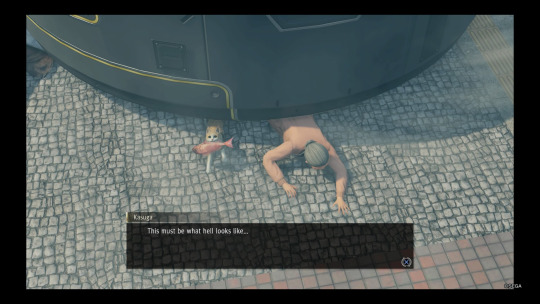

The bartender of Survive also looked very familiar. I mean...what with the huge scar across his face. My suspicions were confirmed when I searched up Kashiwagi up on the Yakuza wiki page and was awarded with the fact that HE MANAGED TO SURVIVE THE ASSAULT HELICOPTER FROM YAKUZA 3!!
Other than that, my few other gripes involved the implementation of the levelling system and the way area of effect skills were handled. In particular, the pathing for how characters moved around the battlefield proved, at least to me, a bit of a frustration. Often, characters would be blocked by a knee-high fence or a corner. Sometimes they would be able to go around, but other times the game (after several seconds of watching them fail to walk through a solid building) warp to the enemy that I had targeted to launch their attack.
And even though the combat is turn-based, most of the enemies tend to walk around the battlefield - either clumping together or distancing themselves from each other. What truly annoyed me was when there were moves that could be used as an area of effect, with the MP cost to go along with it, but were limited by their effectiveness when the enemy combatants were too far away. Yes, it makes sense, but golly gosh, how much of a pixel measurement does it have to be for it to not hit?
Besides that, the levelling was also a bit of a tedious chore. Were it not for the invested vagrants, I feel like I might have put the game down with how much grinding there was - particularly when it came to the various jobs. The biggest hill to climb was from 20-30. Without the exp (experience point) boosting items, it would have been a torturous slog. I know that in the original Japanese release of the game, the cap for jobs was level 30, but if you change it to 99, please, for the sanity of all the gamers out there, tweak the requirements to make it easier. And maybe give normal trash mobs a bit more experience points for the playable characters to munch on.
Goodness, imagine having to grind on level 55 Ornery Yakuza and receiving a paltry 1000xp for each battle (when, in order to level up a job, you needed almost a million).
Yakuza: Like a Dragon is a break from the traditional formula that’s been a staple of the franchise for many years. Much like Ichiban, it’s a bit of fresh air to liven up the experience that might have gone a bit stale after I slogged through the whole Kiryu arc last year. With a few tweaks, and a few more Persona 5 CD soundtracks, I’m eager to see how the story evolves and whatever contrivances Ichiban will somehow force him into.
Although, to be fair, is it still appropriate to call this franchise Yakuza when the game literally saw the dismantling of the two biggest clans? Then again, Civilian: Like a Dragon 2 just doesn’t have the same ring to it. In any case, I hope the next one comes soon and we’ll be able to have Seong-hui in our party. I feel like she’d be wielding a gunblade.
(Did I just use a lyric from Mariah Carey? You bet I did! I had been tossing up the idea between this line and ‘I need a hero.’ Why? Well, I think that would be self-explanatory after knowing Ichiban’s proclivities. And it fits so, so, so well!)
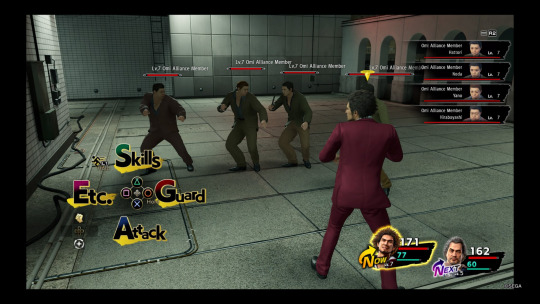
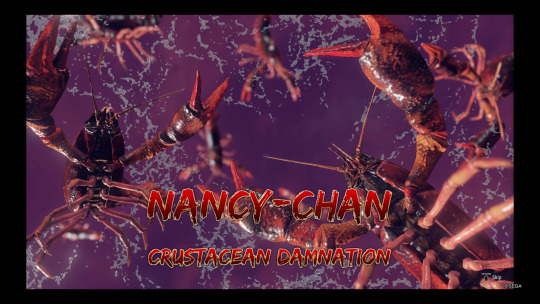
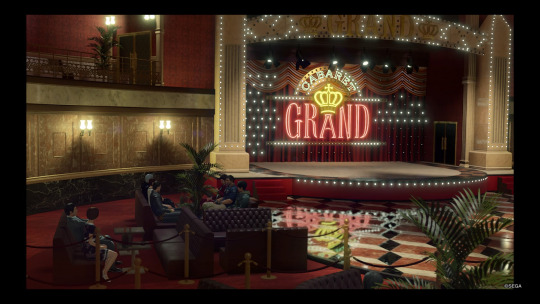
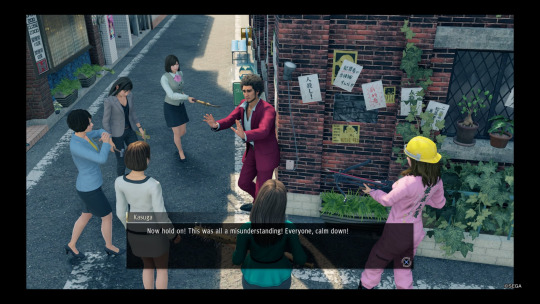
9 notes
·
View notes
Text
Furutod vs Sebastyun

Dear @gisellehexen89,
First of all, I am very happy you seem to be enjoying my blog! And thank you for the interesting ask.
I think the best way to find out what ‘Elisabeth’ is is to read up on it, or watch it yourself; it is impossible to explain everything in a post. After having learned what the musical is about, and you’re interested in how TOHO staged it in 2019, I recommend reading my full art reports:【ACT 1】 and 【ACT 2】. These two reports also show my general thoughts on Sissi (^ω^)
Now instead, I shall dedicate this post to making a comparison between Furutod and Sebastyun.
Furutod vs Sebastyun

When Furukawa’s role as Der Tod was initially announced, most people believed he would be very similar to Sebastian. It is an easy trap: both characters are non-human, have very little scruples, are fiercely attractive, and the theme of obsession is omnipresent.
But honestly, that’s it. That’s all the similarities these two share.
1. Status
The biggest difference between Furutod and Sebastyun is their status. Furutod is the Lord of the Underworld (黄泉の帝王), and absolute authority over life and death of all that is alive. Sebastian meanwhile, is bound to servitude who cannot even wield full autonomy of his own. Needless to say, their difference in power status decides everything in their respective behaviours.
1.1. Sebastian
Let us look at Sebastyun first. All three Kuromyus from the Furukawa era show very clearly that Sebastian is very limited in many fields, but the difference between the ‘mask of the butler’ vs ‘the raving demon’ is clearest in ‘Tango on the Campania’.
In the scene with Edward, we see the boy pulling rank on ‘a mere butler’. Edward was basically threatening O!Ciel using Sebastian, while hiding behind the face of ‘a loving brother’. There was nothing Sebastian could do as a mere servant, so he very explicitly checks first whether Edward had left, before he could show his true reaction: “whatever.”
In the cinematic record too, Sebastyun clearly disagreed with what his master demanded of him, and he only showed his BIG ATTITUDE after the boy had left.
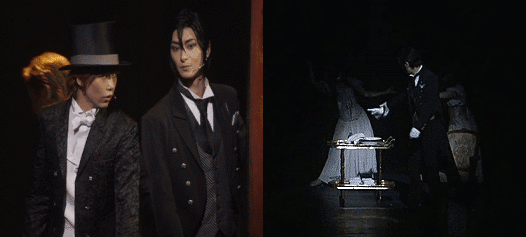
Likewise, as explained in this post, because Sebastian is always bound to servitude, his autonomy (or whatever little he has) is something he treasures a lot. His only outlet of freedom is being pedantic and obtuse. Sebastyun takes it a step further by being passive-aggressive on top, a trait Furukawa has made his Sebastian famous for.
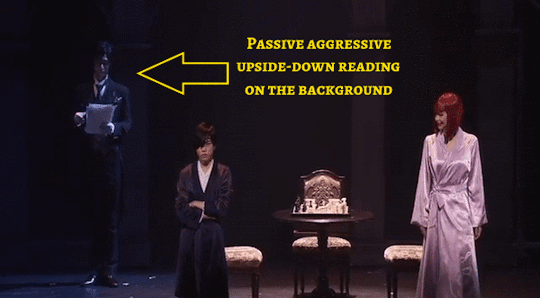
Obviously Sebastyun sees fun in doing so, but this is undeniably the result of a long history of getting his autonomy denied. He is the servant in the shadows who needs to wield power within other people’s boundaries.
1.2. Der Tod
As I mentioned above, Der Tod is the Lord of the Underworld, and as Furukawa himself interprets, represents the authority over both life and death. He never has to ask for a ‘yes’, other people’s consent or opinions are non-consequential to him. He takes lives because he can, and nobody can punish him for it.
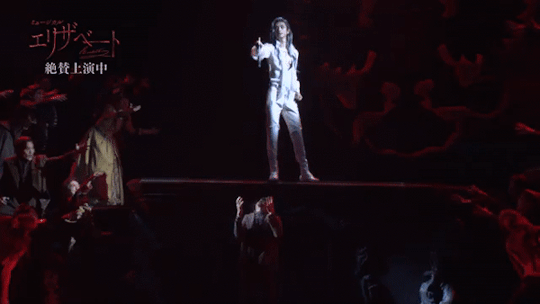
Being an existence who never needs to learn accepting a ‘no’, he does not need to put up a face, because he never needs to make compromises. Der Tod is SO used to getting his way, that teasing the possibility of ‘not getting his way’ is even a game to him.
1.3. Comparison
Sure, Sebastian also teases and pushes his limits sometimes, but unlike Der Tod, Sebastian does have to consider having to reap what he sows. If Sebastian fails and breaks his contract, surely something terrible awaits him. But Der Tod? Nah... his Death Angels will clean up his mess.

Der Tod can afford to make mistakes in playing with his prey, unlike Sebastian. In The Last Dance↑, we see Furutod make the biggest miscalculation; scaring Elisabeth. Had he not scared her, then Elisabeth might have been quicker in agreeing to die for him.
Unlike Der Tod who has minions to clean up his mess, Sebastyun does need to make careful calculations.

2. Understanding and Interest
Another major difference between Der Tod and Sebastian is their understanding of and interest in human beings.
2.1. Sebastian
The thing Sebastian keeps saying is how interesting humans are; Sebastyun is the scientist always hungry for more knowledge, and humans fascinate him to no end. In ‘Tango on the Campania’ even with debilitating pain, he was smiling with the excitement at human behaviour.
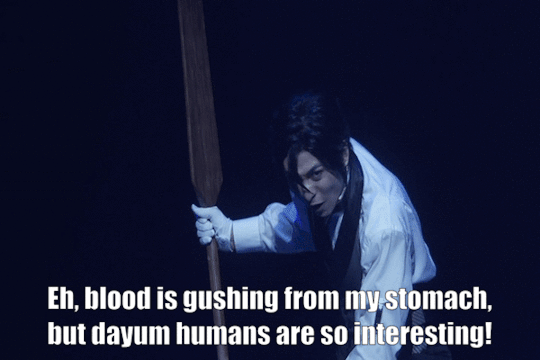
He also makes use of whatever knowledge he has acquired throughout his centuries on earth to get what he wants or needs. Like I said above, at some point in history Sebastyun learned that fear would cause a human to shut down, so he was careful in not scaring Beast, lest she might not open up to him.
Had Sebas been a bit of a dumb-dumb and scared Beast the way he did in the manga, or the way Der Tod scared Elisabeth, then he would have failed his mission logically speaking.
2.2 Der Tod
Der Tod in contrast, always gets his way, so he does not need to understand humans to achieve anything. But more importantly, he is superbly uninterested in understanding humans. The only reason he shows interest in humans is for himself; he wants to bend humans to flatter his own ego. “If Elisabeth finally begs to die, then I AM the victor. If Rudolf commits suicide, then I manipulated him.” Der Tod’s satisfaction is the goal of his actions.
As such, when Rudolf ‘HAD THE AUDACITY to bore LORD DEATH’, he bitchslapped him before taking his life. When in the end Furutod did get Elisabeth, but not in a satisfactory way that assured his baby ego that he’s the winner, he was disappointed and lost all vitality.

To Sebastyun however, the satisfaction is a bonus: it’s nice to have, but it’s more important to get a job done.
3. Mannerism
Another point of difference is their mannerisms. Sebastian is a mere servant, and therefore needs to keep to the shadows. He usually tries (though fails) to adhere to the Victorian code of ‘servants should be like furniture, speak only when spoken to’. (In truth, Sebastian talks way too much for a proper Victorian servant, but he tries! He tries. Give the butler some cookies for trying.)
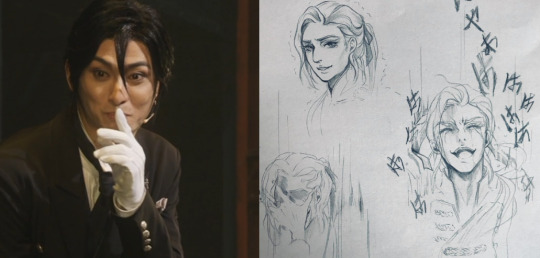
Der Tod meanwhile, is the supreme overlord of all and everything, so he does not need to care about anything. Plus, he can turn invisible as he likes. Unlike Sebastyun who needs to suppress his laughter or any other commentaries, Furutod can get away with laughing like a f*cking hyena on crack during an Imperial wedding.
4. Ego
Lastly, another stark difference between Sebastian and Der Tod is their ego and their presentation of themselves.
4.1. Sebastian
In this post I explained how Sebastian is very willing to humble himself, to come in second place, or take whatever disadvantage voluntarily for the sake of achieving something he wants or needs to.
This is because Sebastian is very secure about himself, and the recognition of humans (cattle) means nothing to him. He does not need anybody to know how powerful he is, instead he takes greater pleasure in silently manipulating others, using humans’ own actions against themselves.

Yes, Sebastian does love to flex, but he does not do any of those things to increase his reputation. We can tell from Sebastian never lingering to check people’s oohs and aahs. It’s like how when we impress a toddler with something easy, we usually won’t indulge in the kid’s praise because we don’t feel an increase of social regard. Instead, the fact that the toddler is impressed with something so easy is more interesting to us.
Sebastian’s flexing seems more like an outlet because O!Ciel forbade him from showing his true potential, and it is frustrating to him. It is just like how we as (young) adults we are capable of understanding deep analyses, but get constantly told to read picture books, on top of also having be content with hearing: “how amazing, you can read a picture book! You are astonishing!!😱”
4.2. Der Tod
If Der Tod was not explicitly ‘death’ personified, I would say that Furutod is ‘huge ego and diva complex’ personified.
Despite being a more elevated being than Sebastian (the scavenger demon) is as Lord of the Underworld, Furutod does like being praised. Der Tod is and will always be above human beings, and that is as boring a fact as water being wet. As I explained in Art report act 1, Furutod suffers from ‘lethal apathy’, and in this sense he needs more than to know ‘that mortals are beneath him, that water is wet’. Furutod wants to know that the mortals fear him, and gets a kink out of mortals being on their knees for him. Der Tod is not just ‘death’, he is the personification of ‘human regard of death’; and the fear of death, is what unifies human kind, after all.

Another point in stark contrast with Sebastian is that Furutod does have kin near him: the Death Angels. The regard of mortals is nice, but he also likes keeping his minions impressed, because his kin’s reverence also means something to him. It is almost like Furutod wants to justify why he should be superiour to the Death Angels (even though his position is never challenged). He just gets a REALLY big kink out of praise, okay? ( ´艸`)
Furutod’s enormous ego also shows itself in his diva-ness. When he is courting Elisabeth for example, he is basically behaving like a peacock. He takes Elisabeth’s hand and runs it through his silver hair, his ivory silken skin. “Look at me, feel me, human, I am SO drop dead gorgeous.”
Furutod also can’t handle being lower than anyone; whenever he has the chance he will literally place himself on higher footing.
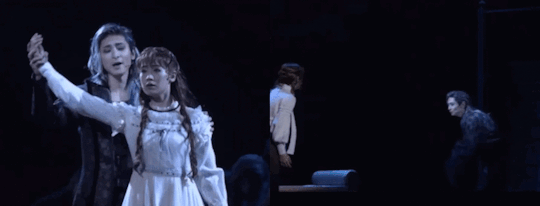
Contrast this to Sebastyun who is always very willing to put himself lower than others. This ⇊ would be UNTHINKABLE for Furutod.
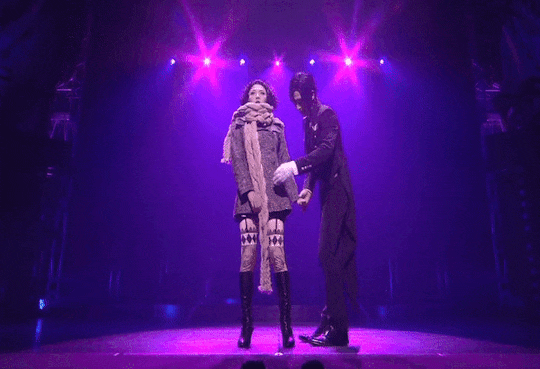
5. Conclusion
In conclusion, besides the ‘non-human character in a dark theme’ aspect, Sebastyun and Furutod really don‘t have anything in common.
5.1. Sebastian
The fact that Sebastyun is always bound to servitude whenever he is on Earth, and his lack of autonomy, shape his behaviour. His reputation on Earth has no meaning to him; Sebastyun is confident about what kind of Demon he is, and the opinions of ‘cattle’ are therefore insignificant to him. The only thing one must not challenge is whatever little autonomy he has left, and he will test and find the upper limit to wield it.
5.2. Der Tod
Furutod in contrast, only knows what it is like to be the most superiour being and never getting his authority challenged. He never had to learn to make compromises, nor does he ever have to deal with consequences. As such he is really a foot-stamping-toddler (Foot-stamping Der Toddler? Sorry.) with a toxic superiority complex and too much power.
Furutod’s supremacy is mind-numbingly boring to him, but there is no way to achieve something grander than what is already grandest. He is trapped in his own mind of toxic superiority and boredom, and will live the rest of eternity searching for entertainment. (It is kind of sad if you think about it......wait, I’m feeling bad for Der Tod? Hmm Furukawa, you really did add a whole new page to the history of ‘Elisabeth - das Musical’)
In short: where Furutod is eternally bored and has no prospect of getting sustainable entertainment, Sebastyun will always have something interesting he might run into.
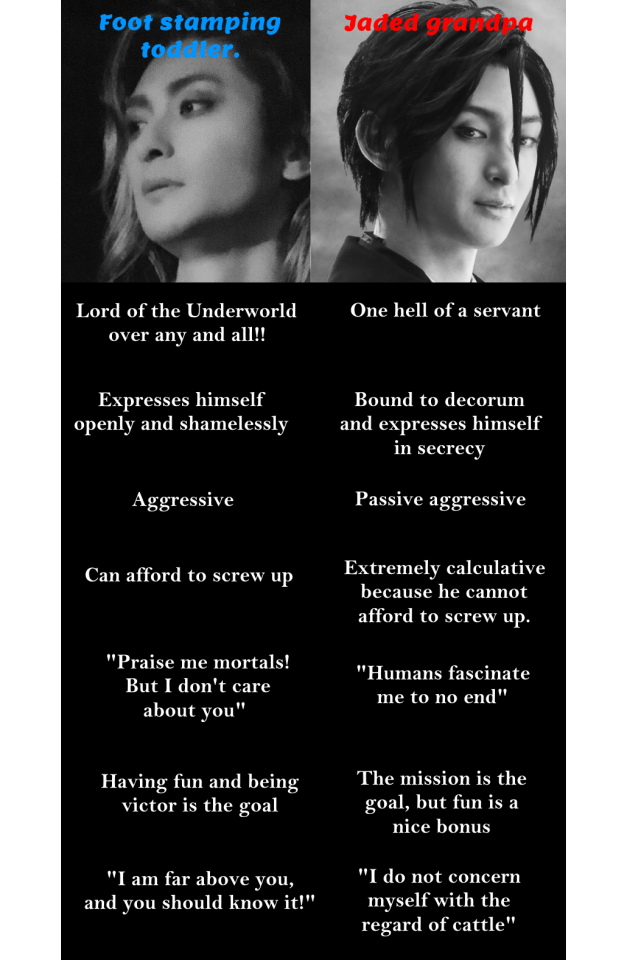
#Furukawa Yuta#Yun#Yunbastian#Sebastyun#Furutod#Yuntod#Elisabeth#musical#Sissi#TOHO#Character analysis#Comparative analysis#Comparison#Kuromyu#Tango on the Campania#Noah's Ark Circus#The lycoris that blazes the earth#Dayum I feel a bit sad for Der Tod now XD wtf?
55 notes
·
View notes
Text
Alienated #1

Alienated #1
Boom! Studios 2020
Created & Written by Simon Spurrier
Created & Illustrated by Chris Wildgoose
Coloured by André May
Lettered by Jim Campbell
Acclaimed writer Simon Spurrier and artist Chris Wildgoose present a subversive coming-of-age story about having all the power to change the world but the unready hands to truly wield it. Three teenagers, each an outcast in their own way, stumble upon an unearthly entity as it’s born. As they bond over this shared secret and the creature's incredible abilities, it becomes clear to the teenagers that their cute little pet is a superpredator in the making—and it’s in need of prey. Guided by the best intentions at first, the teens' decisions soon become corrupted by adolescent desires, small town jealousies, and internal rivalries, sending them into a catastrophic spiral of their own making.
First things first Run don't walk, Corre, no comines, to your shop or simply call, message them or however you get your boos ASAP! There's a reason the first issue sold out before hitting shelves and by golly you don't want to miss this! This is the years hottest debut and it's well deserving of me saying that!
Simon really manages to do something special here and in some weird way I feel it's a modern day science fiction take on Stand By Me. As odd as that sounds I hadn't quite realised it until I started writing this but it really does feel that way to me. The opening introduces us Samuel, Samantha and Samir oh let's not forget Leon too as they all head to school and how Leon affects each of their lives. It is poignant, powerful and completely true of being a high school student at given point in time in history and I know I feel that connection and it pretty damn near immediate. There shouldn't be a person alive, unless you were completely home schooled, that won't be able to relate to what is being portrayed here and it's powerful stuff.
The way that this is being told is practically perfect in every way. The story & plot development that we see through how the book is structured, how the reader learns information and how we see the sequence of events unfolding is bloody effin brilliant! The character development is utterly sensational as we get such a good look at three very different kids and the world that each lives in. The pacing is superb as it takes us through the pages revealing the twists and turns along the way and it keeps the reader glued to the page. The way this all works together to create the ebb & flow for the books is a kind of lulls you into this amazing cacophony of the unexpected.
The interiors here are so gorgeous. The linework is laid down with such aplomb and the varying weights being utilised to bring out this level ad quality of attention to detail is so gorgeously rendered. The way backgrounds are utilised throughout makes me happy! They do wonders in setting tone, mood and feel as well within the composition in the panels bring this depth perception, scale and overall sense of size and scope to the book. And the detail oh the detail and that extends to the colour work as well as Samir's pants more than adequately demonstrate. The utilisation of the page layouts and how we see the angles and perspective in the panels show us this really rising star's eye for storytelling. The creativity and imagination we see, especially that two pager and the last few I mean wow. The colours here are amazing and to see and sometimes they just a smidge past expectation and it works superbly that way. To see how the various hues and tones within any given colour are utilised to create the shading, highlights and shadow work is sublime.
Look regardless of what I say or think or feel I think you should check this out and see for yourself how well this book is done. Maybe you'll see other connections, feelings or even comparisons I don't know, I hope you'll let us know I'd be interested in hearing that. For me this now blew me out of the water but they did it with the power of a single feather.

2 notes
·
View notes
Text
Susir
This time around, we have the last of the four Elemental Lords from the Tome of Horrors 4 but appropriately, we’re going out with the first of the elements alphabetically – Susir, the Lord of Air Elementals. These immense beings make excellent stand-ins for “merely” superbly powerful elementals, the kinds of elementals that even elders bow to, able to command their lesser kin and wield an array of spell-like abilities of the proper element, or they might be gods, granting the appropriate elemental domain and one other. In Susir’s case, that second domain is Weather, straightforward in all the ways that Inder’s domain of Healing isn’t. Of course the elemental lord of the winds has Weather. There are other domains that would have been interesting – Trickery, say, or Freedom – although in my opinion the worst part of it is that in addition to being a bit cliché, Weather and Air overlap on several domain spells. Between that and the description of Susir as disinterested in combat, you get an impression of a divinity that cares only about the sky; the earth and waves are just an impediment, necessary evils for the endless churning of air. Anything else is just smashed through or blown away so Susir can return to things he’d rather be doing, and his combat tactics suit that, unleashing chain lightning before battering through the obstacle in the form of a massive whirlwind.
Though unconnected to the giant pantheon, many cloud giant tribes still worship Susir as a progenitor and a power of the sky they adore. His priesthood, swearing oaths of strict neutrality and allegiance to their god, is one of the few groups able to bridge the gap in cloud giant cultures and intent on doing so permanently; for his part, Susir is largely apathetic and disinterested in the problem though he is content with their worship. Three priests prepare a ritual to summon Susir, intent on receiving their god’s blessing on their goals in person, an action that will move the elemental lord’s attitude from “blithely detached” to “incandescently enraged”, unleashing his literally tempestuous ire on the giants, the immediate area, and anything within reach of the storms he conjures up if the summoning isn’t stopped or somehow contained.
The gas giant known as Yazethi is famed throughout the Free Sectors for the massive golden storm that lies in its southern hemisphere. At the heart of that storm is a massive air elemental able to command the whipping winds that roil Yazethi’s atmosphere, blowing across the earthmotes that float in its skies and scouring some of them clean when the winds howl. Known to offworlders as the Speaker of Yazethi, the elemental is little interested in their concerns, deigning to accept offerings of praise and prayer and offering little more than a certain minor peace from the winds that forever race around the massive world in return.
The faith of Susir demands sacrifice. Unlike many faiths, this is not because Susir demands it as such, nor is it simply an act of faith. Susir’s attention is so consumed by wind, rain, and cloud that without something dramatic, he simply doesn’t notice much of what goes on beneath the all-spanning sky. These sacrifices are not necessarily bloody and brutal but they must be interesting – the point is to get Susir’s attention, after all, and he rarely views the surface as being of much interest beyond a certain bemused, detached granting of spells to his worshippers.
- Tome of Horrors 4 86 (domains and Command Elementals description on 83)
Just a question I had thinking about that first seed again: If something is worshipped by members of a society, does that thing become part of the pantheon of that society?
#pathfinder#D&D#dnd#dungeons and dragons#dungeons & dragons#frog god games#tome of horrors#elemental#outsider#air
7 notes
·
View notes
Text
Lance Birthday Week!! - 3/7
@mcclainetwork‘s Birthday Week for our favourite Blue Paladin, more than just a boy from Cuba to us all, continues! So does my contribution spanning the full seven days. A series of Fan Fictions covering each of the daily prompts. This one seems to have gone a little off the rails in a good way. Never thought I’d be writing from a Lion’s Pov. A part was also inspired by this post from the lovely @anchoredtether.
Be sure to check on the previous parts because, like Voltron, it’s all connected.

DAY 3 - Red
Those Whom I Have Homed
Running his hand over the almost impossibly smooth metal, Sam Holt smiled, his lips and grey beard curling to an awed smile. Somewhere between reverence and fear, the elder Holt looked cautiously into the gently glowing eyes of the Red Lion, finding only unexpected kindness therein. Amid the vast hangar, retrofitted hurriedly into the Pit-Stop of Lions, Sam sat. Machinery of coalition worlds without number were scattered, stacked and partially unpacked around his seat beside the Red Lion. Today alone had shown Sam such miraculous little wonders as the Olkari Echo Cube, Reiphodian gravitation webbing and the subtle nuance of pre-imperial Galra poetry as translated by an Altean linguistic scanner. He was sat amongst the kind of technology that most humans had only dreamed of, himself included. Cataloguing them as if they were mere odds and ends to be later used simply as tools, no more incredible than a pencil. Proof positive of alien life and of whole new branches of scientific enquiry were already gathering dust. Any one item would have been enough to make a career out of in any other context. Now though, the cerebral had to give way to practical. Still, when he had a spare moment, such as this, he took the chance to examine the most incredible of all the technology here. The Lions. Today, if only for not previously having tried, he had chosen to sit alongside Red.
“I still find it remarkable...” Sam's tone was peaceful, “The nature of this metal. The warmth of it, the sensation. It feels almost as though I'm holding my newborn children again. Like a heartbeat from the universe...”
“That's great and all, Sam!” Hunk called back, “But I'm about to...” His voice was drowned out by a loud clattering of boxes, their heaving mass bashing into the floor. Mercifully, none burst open. Though one was resting quite painfully upon Hunk's toes. The protection of his usual civilian garb offering not much in the way of defence. “Ok, just a tick too late there... Little help...?” Hunk asked with a heaving squeak of repressed pain.
Sam stood himself slowly, shaking his head, “Let the work set aside for a while, Hunk.” He smiled, even as Hunk busied himself tidying the boxes aside. “I know you've been trying to balance getting things ready here and organizing that party for your friend. Really, you should take a break for a little while.” Sam sat himself again beside Hunk on an overturned container.
Hunk sighed, setting himself heavy on nearby a box, “Well, you're not wrong. Between Coran and Pidge, I feel like I've been put through a marathon. Throw in building Earth's defences and I just want to sleep...” He made a grab for a small plastic tub, cracking open the pliable blue lid and offering it to Sam, “Free sample. Not my best work. New recipe I'm trying out with ingredients from across the coalition. I think the Nemdari Cinnamon is touch a touch too fizzy...”
Biting into the iced roll, Sam's response was a pleased hum, “It adds a little character.” He laughed softly, “Honestly these are superb. No need to be such a perfectionist, is there? Take the risk, bake something great!” He parodied his own favourite saying with a self congratulating laugh.
“Alright, if you say so...” Hunk smirked, glancing to a large array of hanging cables and cobbled together boxy looking devices. The entire odd assembly hung over the Red Lion's head, set upon a large set of mechanised rails. “Is that ready Commander Holt...? Still looks a little on the hodge-podge side...”
“Sam is fine, Hunk. You know that.” Commander Holt chastised just a touch, “And yes, Cadet Garret...” He teased, “I've just now put the last few touches on the scanning array. Had a little trouble getting the Galra and the Olkari systems talking first to each other and then to the Taujeerian systems.” He sighed, “But, in the end and now owing a favour, I got it working after all. Which reminds me, you know Harris from Tech? He needs a batch of muffins. I'll owe you instead.”
Hunk grumbled to himself, “Fine. I guess I'll be opening a Yellow Lion bakery when all this is over... If it's ever over...”
Sam nodded sadly, “If indeed.” He agreed. “Now, all that aside. I think it's time we set this scanner here in motion, don't you? See if we can't just possibly find something fascinating eh? Bound to be a little something within a part magic part science sentient being with a body made of a comet from outside the universe, right?”
Hunk agreed, following Sam to a nearby workstation with nothing but a laptop. “You sure this is going to cut it...?”
“One nano-millimetre of Red's structure. Just a proof of concept really. It may not do it superbly quickly, but it will certainly give us something to work with.” Sam looked to the scanner and nodded, “Alright!” He smiled, striking a key. “Here goes nothing.”
Strange energies awaken ancient memory.
“They are remarkable, my husband.” Her soft tone lost to the millennia, in my mind she speaks again. Beside her, unknowing what shall pass and hopeful for the future, My Paladin. “Even standing near them, it is as though... Reality bends to them...”
“It's not far from the truth.” My Paladin agrees. My Paladin knows. “Maybe it bends to them and recoils from them all at once.” His young eyes regard my young chassis. Much is yet to pass. Much is yet to be known. My Paladin, in my mind, lives once more. His absence is never far from me. His was a will that binds and guides. His was the power of hope and unity. His was the heart of the Five of Us. My Paladin. My Creator. My Lost Friend. He places a gentle palm to his queen and beloved. So often have I known My Paladin's mind, I feel their bond of quintessence as if we three were one. They have created another. “The Lions of Voltron will serve as the hope of the Universe. I want to give our son...”
“...or our daughter.” She corrects My Paladin.
“Our child.” My Paladin agrees. “The best possible future.” My Paladin shall never forge this future.
I am saddened that it is so.
My mind moves.
As it moves again it stays in motion. Yes! The thrill of battle fills me! I am among the stars. Cold metal shears beneath my might! A blade in the darkness cuts deep into the fray! I am pounced upon and spin, I fire forth such fury!! Another reduced to nothing and still, he calls out within. My Paladin. That he has rage I know well, that he focuses that anger I know well. That when I am wielded by him and he by me, there is nothing in this reality to stand before us. And the memory is good. The satisfaction at each fresh enemy reduced to atoms. The hunger for the battle, it always burns within him and so too in me.
My Paladin is uncomplicated. Yet, he is guarded. My Paladin seeks simplicity. In truth, much is hidden. In battle, he understands. In battle, there is nothing but his instincts to rely upon. Something perhaps of his other side that no other yet knows. Yet they shall in time. When he is my guide and I his champion, it is a deadly dance we weave and cleave upon the stars. My Paladin, he has so far to grow and yet so much skill already.
Again my mind moves.
We are as One. Our Paladins and Our Selves. One. Here in the moment, I feel him. Once my own, now Paladin to Black. A sword. Fresh forged. That was My Paladin. He is tempered now. Wisdom and time have quenched him. Raw power now a strong weapon. My Paladin. I trust you unto Black now. I know that you are ready.
We are as One. And we charge.
My mind moves on again.
He stands. So meek before me and unsure. My Paladin? This? It seems a joke at first. Then, I truly see. Even in my thousands of years, I trust too easily the surface. The mind of this boy is doubt and fear. But the spirit? Yes. The spirit, the quintessence. He is My Paladin. When we fly it is not always smooth. He always apologises for every bump. When we fight, it is not always elegant. But his heart is always in the right place. His motivation. His mind. His quintessence, pure. He has such love within him. Love enough to sacrifice his very self. I feel him pass again. My Creator's Last gift to the universe. She keeps giving still. She returns My Paladin to me. I feel him rise again.
Deep within him, unknown even to himself, he guides and inspires. There is greatness. Bound greatness, shackled only by self doubt. And then, there are such dreams. Across the gulf of space, as we journey to his home, his dreams fill me. Strange and wonderful. Family and Friends. Hope for a future free of war. The many faces and smiles he has loved and longed for and lost. My Paladin, Lance. He reminds me so much of My Paladin, Alfor. Neither of them acted in rage nor anger. They act in defiance of darkness. They act at the behest of the universe. They are not men of war, but guardians of peace. Such nobility and courage in them both. I am honoured to be and have been their Lion.
My mind moves and we are as One again.
We call upon the sword. She is nature's wrath and wielder of the shield. I am fire, creation and destruction alike, who bears the weight of the sword. Each of us have our place. We draw together. Closer. I feel her quintessence as if it were my own. Or it is perhaps my focus is only upon her. If feel her Paladin as though she were my own as she feels mine. My quintessence seeps into hers and hers to mine. We are One, yet we are distinct. We touch. For a moment, we are truly One. Or so it seems to me. As we draw apart, the blade ignites. I feel the ties of our quintessence grow taut and strained, yet always present. And for a moment, weaker, growing, reaching, threads tying ever closer, Our Paladins. I have no time to think on this. The Battle must be won once more. We are One and again we charge.
My mind moves to the now.
Yellow's Paladin is concerned. The creator of dear Green's Paladin stands expectantly. Another war approaches. Another front to ever more defend against the darkness. Somewhere else upon this world, I feel his quintessence. What he calls, his soul. His soul reaches out to mine and to one other strongest of all. Yet, it spreads further, like a web of threads combined. Such love to give and to share. So many to protect. And also, I feel it. The power to do so.
Perhaps, My Paladins and I will yet forge the future they dreamed for...?
The sound of the clicked key had barely faded.
“Well.” Sam waved his arm furiously, trying to waft away the smoke from the sparking laptop. Not long after the scan had begun, the poor quantum processors he had assumed fit to the task were now, to use the newest technical term, QUBAR. Quiznaked Utterly; Beyond Any Repair. “I was not expecting that. More than it could handle I suppose”
Hunk pulled a nearby extinguisher free, smothering the laptop in flame proof foam. “There wasn't even enough time to upload the data...” He ruminated, “I don't suppose Iverson would let us jack into something with a little more oomph, would he?”
“Most likely not.” Sam considered the base computer reduced to wreckage, “Most likely not...”
It was then that the older man's expression subtly changed in a way Hunk was not familiar with. As the two of them cleared away the remnants of the laptop, Hunk awaited something. Though he had no idea what.
“So Hunk, could you perhaps tell me a little about this friend of yours, Lance?” Sam asked in a very fatherly way. The kind of tone that suggested he was very concerned really, but wanted to appear unconcerned, “Didn't really get a lot of chance to talk with him back on the castle, you see. But ever since my little girl came home, well, his name seems to keep cropping up a lot. Excited about a party for Lance, wanting to meet Lance's family. Deciding who gets to keep her and Lance's adopted child she said... Thankfully she was just talking about Kaltenecker. Gave me a little fright, honestly... There was talk about who keeps the games console and on what alternating days they'd trade, who'd host game nights. Talking with Colleen about picking out the right dress for the evening. Things like that. Gets the old noggin joggin' as they used to say.”
Hunk could feel his stomach squirm as he nodded, offering only a nervous, “Mmmhmmm...” In response.
“They must be very good friends, is what I would assume.” Sam nodded, “Though, I wonder... As a concerned parent might, you know? I'm probably being over analytical aren't I? But is he a good man? Good head on his shoulders? I'm sure he must be, right?”
Hunk fell into silence as he carefully considered his next words. He could already see himself setting hours aside for baking, this was going to be an even worse interrogation than Iverson's debriefing. “Could my favour be not having this conversation...?”
Sam smiled kindly. Then shook his head.
Red, sat silent and ever patient, returned to his thoughts once again.
#Am I shipping the Green and Red Lions now? What do we call that? Greed?#mcclainetwork#plance network#voltron legendary defender#Fan Fiction#Lance Birthday Week#Julance#vld#vld Lance#vld Pidge#plancenetwork#plance#pidgance#flirtyrobot#seasalt#smartwater#pance#rainforest#pikelavar#pidge x lance#lance x pidge#lance/pidge#pidge/lance#lidge#F*ckplant
35 notes
·
View notes
Text
Project Zero 2: Wii Edition and the Remake Dilemma

I’m a firm believer that remakes are typically losing propositions. There are cases that buck this trend as there always are (Resident Evil comes to mind), but when it comes to games that can be considered landmark titles in their respective genres, or just superbly made games, the benefit of a remake is limited to its availability on new platforms. This is something a port could accomplish with significantly less risk of messing with the integrity and intent of the original creation. Sometimes, though, games are completely overhauled for one reason or another. Project Zero 2: Wii Edition falls into this category.
A remake of the 2003 PlayStation 2 and Xbox release, known in the US as Fatal Frame II: Crimson Butterfly, Project Zero 2: Wii Edition uses two basic templates from which it forms its mold. The first is the original game. Fatal Frame II was a pretty big step forward from its predecessor. It maintained the basic underpinnings of exploring haunted old buildings and fighting ghosts by taking pictures of them with a magic camera, but it added some significant and interesting changes. In Crimson Butterfly you don’t go through the whole house of horrors alone. Your twin sister often tags along as your AI companion. This means she can alert you to the location of ghosts, and can also become the target of their attacks. The mechanics of camera combat are tweaked as well, where your proximity to ghosts is used to scale your damage up more than the time multiplier used in the first game. Because of this, ghosts often have jittery animations that make getting close to them risky and capturing them with combo inducing fatal frames difficult. The explorable area is also expanded out to several sometimes connected buildings and the space between those buildings in a small village compared to the single mansion that made up the first game.
Wii Edition borrows Crimson Butterfly’s structural framework practically wholesale. The level design in almost unchanged, the combat parameters are pretty much the same, and your AI sister manages to get in your way just about as often. What’s different is everything else. Shedding the fixed camera angles so common in survival horror games, Project Zero 2 takes its presentation from its console release cousin, Zero: Tsukihami no Kamen. Released four years earlier in 2008, Tsukihami no Kamen completely shifted how the Fatal Frame games were presented to players and how players interacted with them. The camera went from fixed and set tracking to being pulled in over the player character’s shoulder. It became dynamic, the player could direct it with a certain amount of freedom to focus on what they wanted to in the environment. Motion control was also introduced to more accurately convey the feeling of aiming a flashlight and camera around. It was a complete break from what the series had been doing up until that point, and Project Zero 2: Wii Edition fully embraces these changes.
The mix of classic Fatal Frame level design with modern Fatal Frame camera angles and control schemes produces mixed results. For lack of a better term, the game is clumsy. This manifests itself in some interesting ways. First is the unoptimized menu navigation. As you explore the Lost Village, you come across a variety of objects that reveal lore. Most of these are paper documents of various types. Picking one up will open the article so you can read it. To close it, you first press B on the Wii remote to stop reading, then press A to close the text. This might not sound so bad, not adjusting the purpose of a single button to match player intent in context-sensitive ways makes quickly navigating the menu both confusing to learn and quite difficult to do quickly. While the backstory to the Fatal Frame games is interesting and worth taking the time to investigate, repeat playthroughs don’t always require that you read a seven-page journal entry again. The menu system actively works against playing quickly or efficiently. Considering how much time players have to spend in menus, missteps here can add up to some significant time loss.
Time lost to players doesn’t seem to have been a concern for Koei Tecmo when developing this game as it also features unskippable cutscenes. Wii Edition is not a game that is overwhelmed by its pre-rendered scenes, but they are frequent enough that they disrupt play in regular intervals. For first time players, they probably aren’t something you’d want to gloss over as they provide guidance on what to do next but they are far, far less important for those who have played the game before. Not being able to skip these scenes is especially odd considering the odds that many people playing the remake of Crimson Butterfly also played the original and are familiar with the story already. Forcing players to watch cutscenes always ends up feeling like the player is having control taken away from them, and it’s especially painful here due to the more general issues with player control.
Perhaps the easiest target with regard to player control is how it feels to move the player character around. Unfortunately, Mio and Mayu feel very slow. Slow movement on its own is not a problem, but the game does not feel balanced around the movement speed. A prime example is the sluggishness of the quick turn. What was a snappy animation that turned you around 180 degrees in Tsukihami no Kamen became a set piece of animation reorienting the character that feels as if it’s playing back in slow motion. The animation itself isn’t even particularly slow, but the built-in delay to the starting of that animation makes the whole thing feel unnaturally labored. It’s a much less useful technique because of this. Timing it right during combat becomes more a test of how well you anticipate a ghost’s actions rather than how quickly you can react, which is unfair to ask of players when ghosts spend so much of their time hidden from player view.
The slow movement might have been the result of the game taking place in such tight quarters, a problem created when spaces aren’t redesigned to match the other changes. The slow animations feel like a safeguard against players running themselves into walls constantly or rushing past something they were supposed to pay attention to. This is taken to an extreme in one particular room where the player can walk through a pair of hanging curtains. Going through them triggers an especially aggravating animation of Mio nervously pushing the curtain back before stepping forward. These animations are triggered by proximity to the curtain rather than the on-screen prompt to press A like in nearly every other interaction in the game. It’s a particularly bad moment. If you just to happen to be ambushed by a ghost while doing this, suddenly you can rush through the curtains at full running speed with no issue, demonstrating the arbitrary nature of Mio’s movement limitations. Unfortunately, the forced pace feels like it creates more problems than it solves. Players just have to suffer through everything taking a bit longer than it probably should, with backtracking or getting temporarily lost compounding the problem.

Getting ambushed here is about as dirty a trick as the game can play.
Combat also suffers some unexpected clunkiness. All Fatal Frame games are a bit clunky when it comes to wielding the Camera Obscura, though this has the express purpose of making the game both challenging and tapping into the fear of the player, who might perform the wrong action due to a panicked state. In Zero: Tsukihami no Kamen, the imprecise motion controls of the Wii were mitigated by the lock on mechanic. One could argue this made the game a bit too easy, but Project Zero 2 for Wii goes very far in the other direction. The lock on keeps your camera in the vicinity of your nearest target, and the player must adjust their aim within the lock by rolling the Wii remote to either side or pointing it up or down. Locking on happens quickly and is accompanied by a satisfying shink sound that provides the player with positive feedback. Hearing it, you get the sense that the hard part is over and now it’s just a matter of waiting for a fatal frame chance.
Really, your photo album efforts are just beginning as the ghosts can easily disappear out of your lock on, reducing your spirit energy levels back to nothing. What you’re supposed to do is lock on, then diligently follow along, making minute adjustments to the position of the Wii remote in order to keep the ghost centered in the viewfinder. This is no easy feat, especially if your Wii remote calibration is off or you have a less than ideal location for the sensor bar. The semi-automated lock on and precision aiming feel at odds with one another. Adding in the analog stick of the nunchuck on top of that for turning your character around and you have three methods of controlling the aim of the Camera Obscura, all of which just get in each other’s way. Its lack of complementary components is all the more surprising since it had worked so much better in the previous Wii effort. While Tsukihami no Kamen’s combat could certainly have used some fine tuning, Wii Edition reduced that complete package back down to its individual pieces without remembering how they were supposed to fit back together.
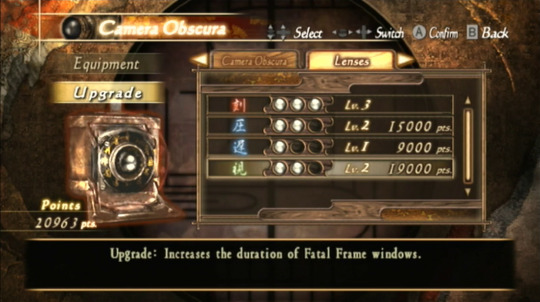
The game really forces you to upgrade as much as possible since your basic film does very little damage and getting fatal frame combos is quite difficult compared to the other games in the series.
A quirkier addition for combat scenarios is the blacking out of the screen during certain encounters. There you are, tracking a ghost as it glides around the room while you charge your spirit meter, when suddenly the room goes completely dark. You lose the ability of your filament to point you toward the ghost’s position right along with the ability to see anything. It’s supposed to add tension, maybe even give you a fright. The first time it happens, it gets close to accomplishing that. At the very least you’ll be surprised. That raising of the stakes fails to deliver once you figure out that the underhanded tactic of your spectral enemy goes away after a few seconds and in the meantime, you can just run around to avoid getting caught unaware. It’s a fun new trick to see once, but it doesn’t force the player to reassess their predicament or use new strategies to deal damage to ghosts. The same exact methods of evasion work just as well, you simply have to wait until the lights come back on to hurt your foe.
Since the game was released in PAL regions, it did receive localized voice acting in English. What might be a surprise to those of us in North America is that the dub was done with English voice actors, meaning it differs wildly from the original English language dub that was produced for North America and PAL regions. For those familiar with the original game, it’s quite off-putting to hear these new voices. For a game so rooted in being Japanese, non-Japanese voice acting always felt a little strange. To their credit, the actors who worked on Project Zero: Wii Edition did a fantastic job, and once you’ve become accustomed to it, I find that it often outshines the original English dub. Sadly, the English dub is the only one you can choose from despite its release in multiple European countries and featuring several language options for the subtitles and menus (I played the Italian release, complete with box art and manual, printed in Italian). The Japanese audio isn’t even available, which is a real shame, as it would have been nice to give the characters their presumed native language to give it that much more coherency. Of course, multi-language tracks were still uncommon in 2012, so you take what you can get.
Aside from getting an English dub, the greatest thing about the PAL release of Wii Edition is that it made the game available to a wider audience. If you only happen to have a North American Wii, however, you face the same kinds of problems trying to play this game as you do trying to play the fourth game. Without a PAL or Japanese console, you can’t simply pop a disc in and start playing. If you don’t want to invest in another console for a single game, then the easy answer is emulation. Wii emulation is in a very good state, so the game is easily playable on PC, though you are likely to get some audio stuttering and maybe a bit of slowdown. You can even get a USB sensor bar and pair your Wii remote with your computer to replicate the control scheme exactly. If you want to play on your North American console, you can also do that thanks to the robust homebrew community for the console. Bypassing the region lockout using sideloaded applications means you can play the game on actual hardware exactly as one would expect, and it works flawlessly. If you really want to, you can also track down an undubbed version of the game which features the original Japanese audio with the texts of the various PAL region languages.
With so many available options to play it, the question really becomes whether or not it’s worth playing. For anyone who loves Fatal Frame, the answer is easy enough. Yes. It’s interesting to see the game redesigned for a completely different perspective. It’s fun to hear the extremely different voice acting, and at its core, it’s very much the same type of game that all the games in the series are. You can’t really go wrong with it in that regard. For those who might be coming late to the series, I’d have to recommend the original over this version. Crimson Butterfly is readily available, can be played digitally in HD via the PlayStation 3, and simply holds up better as an overall package. If you love motion controls but only have room in your life for one Fatal Frame game to try, then you’re better off going with Zero: Tsukihami no Kamen. It’s more responsive animations, more appropriately designed locales, and tighter Camera Obscura mechanics make it the obvious choice. It also incorporates the Wii’s motion control gimmicks in interesting and surprising ways that truly enhance the experience, something Project Zero 2: Wii Edition curiously omits. For a remake, Wii Edition doesn’t make much of a case for itself being the definitive version. It acts more as a companion piece to the original, a super new game plus, almost. It’s one to come back to only once you’ve made your way through the rest of the series and still want more
3 notes
·
View notes
Note
Darius's axe doesn't cause bleeding out of sharpness but the way he swings it. It makes sense that most foes would be armored in some form, so there must be some technique to it as sheer sharpness coming from an axe seems unlikely. The weight and a broad bevel, however, would act more like a log splitter to crack into armor where a sharp tug would slice flesh. It makes sense considering might doesn't necessarily have to mean raw physical strength. The skill to finely wield power is might as well
tell me a headcanon you have for darius | @arcanist-mcallistaraccepting.
ooooh, i really like this because it does align with the headcanons i already have!
for an example, i headcanon his habit of using the back of the axe comes with the need to shredding / cleaving through armor and he’s got enough of the eye and expertise to manage (hence why he holds his axe as he does and hence why one of his skills literally give him armor pen., AHA!) it very often against his foes. surely the axe is sturdy and finely crafted enough it makes the task easier, but there is an undeniable amount of skill that comes with how much success he has at it.
noxian tenets make what you say true, too. they don’t recognize only might in sheer physical prowess, but in skill. darius is obviously completely capable when it comes to raw strength for human levels, but he’s honed his techniques enough that he’s feared for them, too. what’s the use of a superbly crafted weapon if you do not know how to wield it to its maximum potential?
5 notes
·
View notes
Text
God of War: “The Dad and The BOY”
God of War, God of War 4? whichever you decide to choose to call it, I payed it, finished it and thoroughly enjoyed it from start to finish, which was a few days ago. It’s fantastic to see a worn out franchise(and protagonist) gain some maturity and depth much later in in it’s life(and the protagonist’s). Now you might have seen the rave reviews, videos, etc, that claim it to be the “Game of the generation!” and while, I definitely think it’s GoTY material, I’m unsure if I’d actually call it that myself.So basically this is why I enjoyed this title.
God of War 4. or stylized as “God of War” is a sorta continuation/reboot of the popular hack ‘n’ slash, ultra violent God of War series developed by Santa Monica Studios. Originally, David Jaffe worked on the original and it’s first sequel, Where as the current title was directed by Carl Barlog. The game follows an older Kratos, who has left Greece to live a life in the Norse Realm of Midgard, here he has a wife and a son. The story follows both Kratos and Atreus(the song of Kratos who is affectionately referred to as “BOY”) as they head to the highest peak in all the realms to spread Kratos’ wife’s ashes, as her last wish. You face off against Aesir, Nordic monsters and undead, and even a dragon along your journey. As it begins, it grows from a simple coming of age tale, to much grander in the schemes whilst ending on that smaller, simpler note akin to the beginning.
First of, let’s talk about characterization, story and writing. Kratos gains a lot more depth than he ever had in previous iterations. Far from the ever rage filled murderer, he’s now cold and distant, averting from his past in a sort of shame filled expression, until he must beckon the call and embrace his past again. He has to teach Atreus how to survive as a warrior, and most importantly, as a man, all the while he’s learning himself on how to be a better parent now that they both lost the matron of the family.Little things from the simple “almost loving pat on the back” to when Kratos allows Atreus to carry his mother’s ashes to the peak, all signify how Kratos grows, and it’s superbly written. We cannot forget Atreus, from his naive “I just want dad to recognise how much I’ve grown” to his sudden realisation(and arrogance spike) that he’s pretty much a god to him coming to terms with the revelation, it’s paced well enough and tugs at your emotional heart strings here and there. Baldr, makes for a captivating antagonist, while you don’t see him all that much? he still is a compelling and surprisingly sympathetic villain. From the brotherly spat and affection of Brok and Sindri to the wry wisecracks and banter of Mimir, and ofcourse Freya, the supporting cast is just as delightful and well written.
The meat and potatoes, the gameplay. You’ll notice how you don’t wield the blades of chaos(not yet anyway) at the start of the game, but the “Leviathan Axe” is now your new arm. Combat is mapped in a Dark Souls like structure with an “over of the shoulder” camera angle added, this heightens just how much more primal, visceral and brutal the game has become. Long gone are Ultra violent, ultra gore riddled kills of yonder, replace with surprisingly less bloody but more grounded executions that still look stylish without it being too much. It’s a MATURE violent game that’s for sure, in both aesthetic and overall feel. There’s also some light customisation and RPG like systems almost similar to Destiny(only done RIGHT!).Bosses are pretty damn fun, although there’s an over reliance of Trolls, I would’ve toned them down a notch but the most fun are Baldr, the Dragon and the Valkyries(although they can be surprisingly cheap at times). All in all there’s a sense of “Metroidvania”aesthetic to the whole game, basically as you backtrack with new found abilities to unlock secrets and more loot and it never feels like you have to get all the secrets in every nook and cranny, you do as much exploring as YOU want to do.
So level design is up next. It’s a breath of fresh to find a game that is both single player, linear and one with an actual fucking story! Levels are just big enough for exploration and moving along the story. It never feels overwhelming or too big, as many “open world” Games seem to feel like in my opinion. There are multiple realms to explore and traverse, even two “Post-Game” realms to get some nifty combat and exploration trials down(One of them being also a Psuedo-Dungeon Crawling like Realm) it’s all made very intricately, with care and attention to allow you to either pedantically explore for everything or to just go along with the plot. Each realm is distinct and eyecatching; to the beautiful and floral aesthetic of Alfhiem to the fiery demonic volcanic browns of Muspelhiem to the eerily deathly green glow and wintry winds of Helhiem.
Next up is visual and sound aesthetics. This is a gorgeous looking game, pure and simple. It’s surprises you how the PS4 can even run it sometimes. While there’s a more gritty, realistic look to it compared to the more cartoonish look of the older titles, it’s still diverse in colours, with Midgard’s mix of whites, brown and golds to the harsh, dreary toned down pallet of Niflhiem, this game will stun you, regardless if you care or not care about graphics or art. Enemy designs are really cool, from the weird witch like Revenants to the large, lumbering trolls, there’s just enough variety to not make it repetitive The sound design is also equally as grand, maybe less so, but that’s not a hindrance at all. From the cackling of the ice as it freezes your foes, to the roars of the ogres and the snarls of the wolves, it all sounds meaty and really big. The music itself is sublime, having this sweeping orchestral score with Nordic like vocals overlayed to give it that extra sense of “Norse Mythgology” Norse-ness. Lastly the voice acting, Christopher Judge was a fantastic choice for a more grizzled, older Kratos, and hopefully something that sticks in future games. Atreus, Mimir, Baldr, etc all have stellar performances under their belt in this title.
Overall, God of War, Dad of War, GoW4, etc is a sublime game and a fantastic exclusive to boot. Carl Barlog put passion and care into making this title, ,the SMS development put their passion, heart and soul into this title, and it really shows through. A near flawless game, made to give a franchise a long needed sense of maturity and depth without losing the fun, visceral and brutality of what made the previous games so popular in the first place. This title alone proves that “Single Player, linear game experiences” aren’t dead at all, it just that publishers like EA, have just forgotten what makes them great. If there’s one nitpick I had to give for the sake of “objectivity£” it would be there’s no New Game Plus mode, but I’m sure that will be remedied in a future update. This game has had almost similar impact on me than Bloodborne had, that is how much I’m recommending it.
Biased Score: A+
Unbiased Score: A
#god of war#santa monica studios#video games#video game review#video games as art#ps4#sony#ps4 exclusive#review#reviews#god of war review#Adventure Games#video games reviews#ps4 pro#action games#norse mythology#norse
3 notes
·
View notes
Text
The Mighty Thor #702 and Doctor Strange #383: Loki: Sorcerer Supreme Part 3, or, Step Up Your Game, Aaron
You know the drill, spoilers, ranting, blah, blah
The Mighty Thor #702:
-Jane Thor is a multitasking masochist with the most superbly jacked arms in all of Asgard and Midgard--with the exception of Hercules, Lion of Olympus, Prince of Power, Proponent of Diplomacy via Arm Wrestling
-Volstagg no :c
-Odinson: “Hey, Jane, friend with former benefits, quick question.”
Jane Thor: “Yes?”
Odinson: “Have you considered maybe, you know, putting down the hammer and taking care of the whole cancer thing?”
Jane Thor: “Not really.”
Odinson: “Cmon”
Jane Thor: “Fiiine.” -chucks Mjolnir into the cosmos-
Odinson: “A little dramatic, considering we are literally inside the godly hospital wing which is even now being put to use on Volstagg to bring him back from the point of death and we could, again, for the umpteenth time, completely heal you using our Asgardian magic without any mortal poison-medicine or chemotherapy or years upon years for a recovery period, thereby allowing you to continue wielding Mjolnir with no negative repercussions. Unless, of course, you’re finally considering putting these resources to use--”
Jane: “But All Magic Comes at a Price and is very Double Terribad, as evidenced during my scoffing at anything too damn ~*~magical~*~ in my first character arc. So yeah”
Odinson: “Yeah”
-no I’m not still bitter who’s bitter not me
- Direct Odinson Quote to Jane Thor: “Frost giants, the Destroyer, the gods of the Shi’ar, the Phoenix, my bastard backstabbing brother, my uru-headed father...you have faced them all.”
- :)
- :))))))
- No One Bitter Here, Especially Not Me
-Local tiny mortal yells at birds, finally gets Odin to come out of the sad cave to chew out slightly-more-assholish brother
-Odin enjoys Allfatherly yelling, throwing around ye olde sexist talk, generally flying in the face of the whole Simonson era-flavored aesthetic the rest of the plot has flying around
-Oh hi Freya, good to see you’re not dead*
_*if only to prove Loki didn’t kill you**
-**and to finally/maybe get the gods engaged in the War of Realms thing***
-***provided we don’t need another Thrilling (c) issue of yet more fucking buildup to the buildup of the rising action of the prelude to actually confronting Malekith and company
-next issue: Jane Takes a very Inconvenient Nap. Damn, if only there was some timely way to heal her frail mortal body and banish its mortal disease, as if by magic. Oh well.
-Heimdall vs Mangog at his Goggiest
Doctor Strange #383:
-buy it
-We get to see the big mysterious sorcery tournament
-Buy It
-Stephen Strange appears to have won it, primed to renew his Sorcerer Supreme title...
-BUY. IT.
-...The Vishanti, the great big mystical hoopla spirits/gods/entities, give him the verbal equivalent of a gold star sticker and tell him, hey, great job, buuut you didn’t win. To which Dr. Strange asks what the fuck kind of nonsense is that. If he, the last sorcerer standing, isn’t the Sorcerer Supreme, who is?
- B U Y I T
- Direct No Shit No Hyperbole Not Making This Up Quotes from the Issue:
The Vishanti: ”Loki Laufeyson.”
Strange: “WHAT!?”
Loki, standing in the corner, in full raggedy green-gold-goth regalia, taking out one earphone: “I’m sorry, what?”
- BUYITBUYITBUYITBUYIT
-Okay, I’m actually shaking here, I can’t bring myself to quote every golden line from this thing, but the basics are
1) The Vishanti essentially appoint Loki as the new top wizard cop
2) Loki is honestly confused, asking if there’s some mistake here, he was just hanging around to watch the show
3) The Vishanti declare, out loud, in print, that while they’re understandably not oblivious to the god’s troubled past, they are also omniscient enough to know and acknowledge that Loki now possesses traits their former lives never did. Caution, restraint, regret, a hunger for atonement and change.
“You wish to forge a better path. Is this correct, Loki Laufeyson?”
“... Yes. It is.” Complete with appropriately sincere and gorgeous expressions on everyone involved.
- BUY!IT!
-There’s more to the story of course, and despite my obvious bias towards the green bean god, Strange and his actions are portrayed fairly and understandably. He’s worried that, appointed protector or no, Loki’s going to try and pull off something too dangerous and is doing what he thinks is right rather than just acting out of jealousy/anger over the talking dog. The guy was ready to spend the rest of his life as a veterinarian until he got wind of Loki’s plans.
-Buyibuyibyurutbuitiurb buiy i it buy the it Buy ITI bUTBit bUTy= but buY
-Weird continuity thing, but apparently when Strange goes to Asgard to chat with the World Tree it’s Cul on the throne rather than Odin. This implies that all this stuff is taking place before Odin’s return as seen in TMT #702. I know, comic timelines are screwy, but the optimist in me wants to think that the reason Jane Thor was a little tight-lipped when Odinson dropped the “backstabbing brother” line was that she didn’t want to bring up that she’d recently gotten no-strings-attached assistance from said brother who was now apparently as worthy of the Sorcerer Supreme title as she was worthy of Mjolnir. Anyway.
- BUY
-IT
Bonus Recommendation: Batman #37, Double Date
It’s an absolutely adorable vignette of Bruce, Selina, Clark, and Lois going to a fair. They discuss their love lives, swap costumes, stop some poor schmuck who steals Lois’ purse within Bruce and Clark’s line of sight, and it’s all a ridiculously cute and perfectly in-character story. I barely ever glance at DC’s stuff, but I’m glad I took a chance with this!
#am ramble incarnate#yelling about#comics#The Mighty Thor#Doctor Strange#jane foster#loki#sorcerer supreme#Batman#marvel#dc comics#spoilers
36 notes
·
View notes
Text
Recently Watched Films
Here are some more films I watched recently and my thoughts on them!
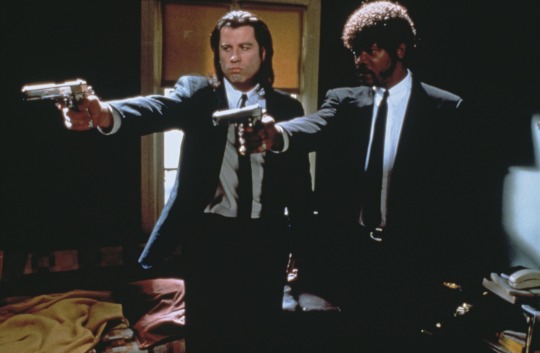
Pulp Fiction - D. Quentin Tarantino (first time watch)
Pulp Fiction has been recommended to me so many times that I felt I had to watch it. Another Tarantino film, but probably my least favourite thus far - although elements were really enjoyable, such as the sequence of Mia and Vincent at the night out. Overall though, I found the unique structure kind of hard to engage with, as I didn't feel like I was rooting for a particular character. Additionally, Tarantino’s writing, or lack thereof, of female and characters of colour has always bothered me - although obviously Samuel L. Jackson and Uma Thurman star, I find myself a bit put off by the way his characters treat minorities and women. Especially when he inserts himself into his films and does questionable things (the scene in inglorious basterds springs to mind in which he himself needlessly strangles Diane Kruger’s character with his own hands... in the name of cinema??) And people let Tarantino get away with this because he’s eccentric and well-loved, but I find it kind of disgusting honestly...Perhaps he’s appealing to human flaws, but it bothers me nevertheless as I guess sometimes it feels like he’s lampshading - effectively not helping the situation and not condemning these characters enough. That being said, the narrative is interesting, and the characters are certainly unique - I especially liked John Travolta’s character, Vincent, for his attitude. Perhaps on a rewatch I’d find the film more engaging. Or maybe I just think it’s fine, but is overrated.
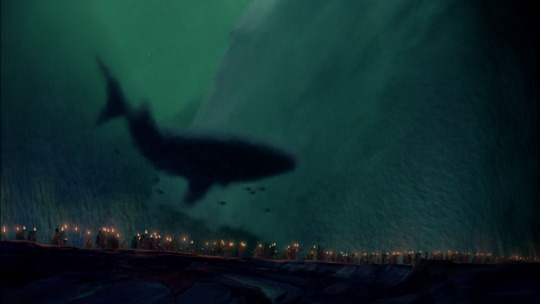
The Prince of Egypt - D. Brenda Chapman, Steve Hickner, Simon Wells (rewatch)
Wow. This film is as beautiful as ever. Perhaps now I appreciate even more the unique and stunning animation, but what stood out to me most was the soundtrack - specifically the introduction sequence, is a masterpiece! ‘Deliver us’ is superbly majestic, backed up by a full choir set on the backdrop of a hot, dusty and grand Egypt built by slaves longing for emancipation. The brotherly friendship and then broken bond between Ramses and Moses is so heartbreaking and yet fully believable - the weight of responsibility to be cruel put on him by his father, drives Ramses to frustration and anger at his brother for being so careless, Moses, who is discovering who he truly is and where his destiny lies. Here Ralph Fiennes and Val Kilmer’s performances are standout. The story is satisfying to watch unfold, and I enjoyed the pacing immensely, feeling every emotional beat. ‘When you believe’ is a thoughtful and beautiful song wielding hope, and allows the Hebrews to walk together, to a future of freedom.
0 notes